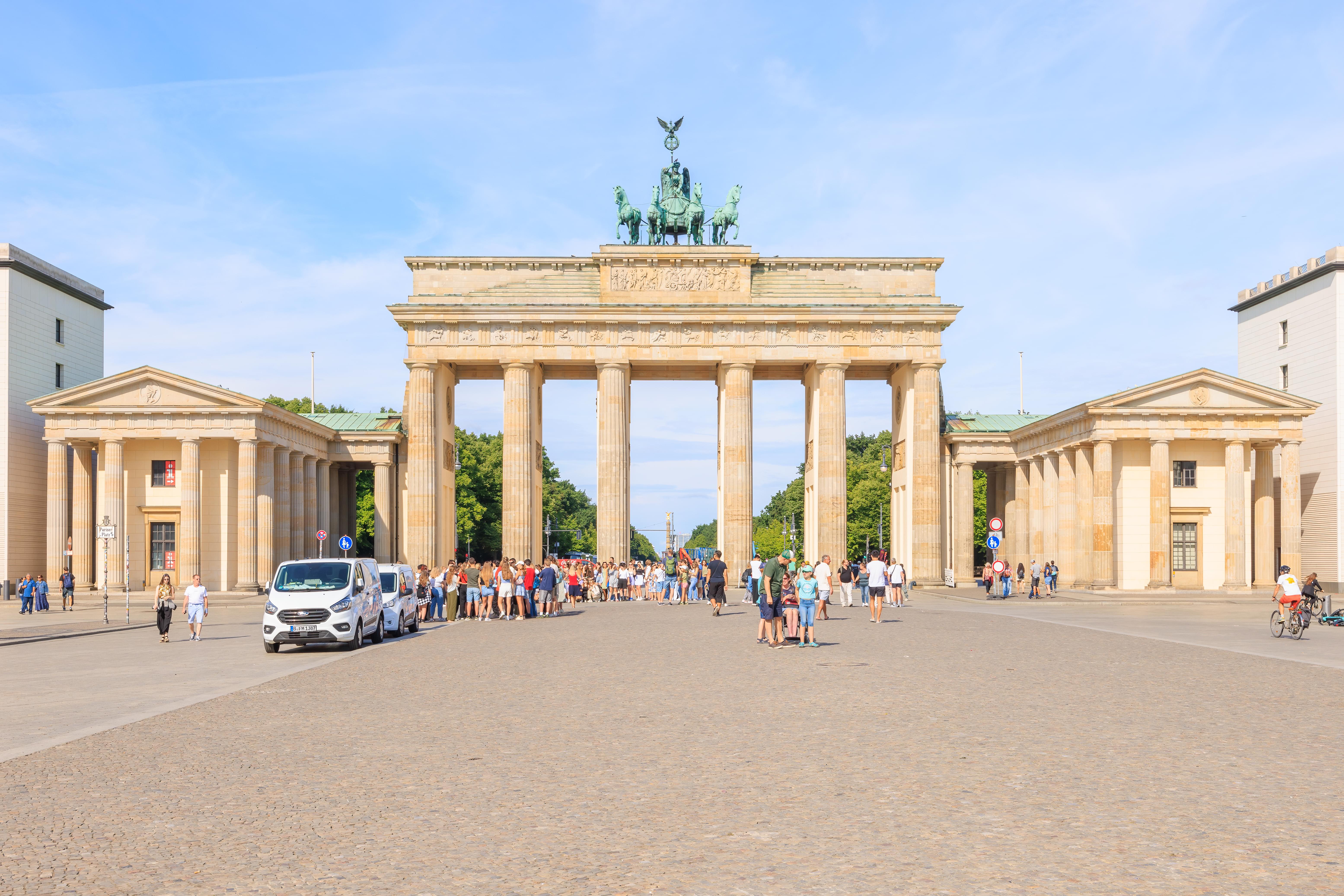We spent most of the day in and around the Tiergarten, a large park on the west side of Berlin’s city center. We started out at the Brandenburger Tor, checked out the exterior of the Reichstag, and walked through part of the park. We saw various monuments and memorials and ultimately ended up at the southwest corner of the park by the Kaiser Wilhelm Memorial Church.
Brandenburger Tor
We started out the day by walking one block to Unter den Linden and then walking west. We were walking on the south side of the street but had to cross as the sidewalk was fenced off.

The fence was in front of the Russian Embassy. Do they want their wall back?

Presumably, these are some of the linden trees that give this street its name. It was still pretty quiet in the area at 9:15am.
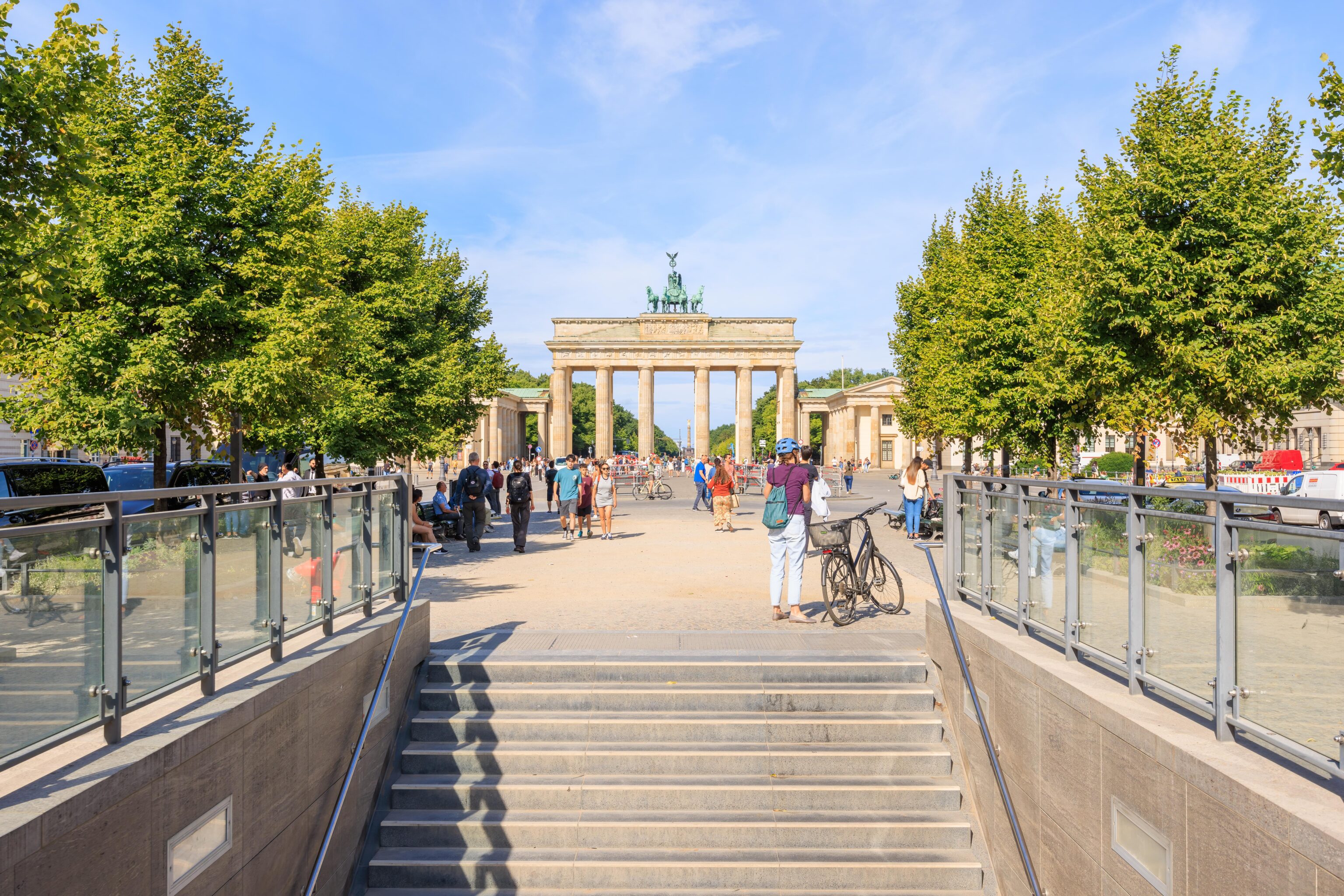
We quickly reached the Brandenburger Tor (Brandenburg Gate) U-Bahn station. We took a photo from this exact spot two days ago when Christopher Street Day was going on. It was much busier then!

There were some large tour groups at the Brandenburger Tor but otherwise there weren’t too many people around. The Siegessäule (Victory Column) can be seen in the background through the gate. It is about 2km away.

The gate’s Wikipedia article describes the sculpture atop the gate:
Atop the gate is a sculpture by Johann Gottfried Schadow of a quadriga—a chariot drawn by four horses—driven by Victoria, the Roman goddess of victory.
History, the cable TV channel, has a page about the gate. It talks a bit about this sculpture:
Built between 1788 and 1791 by Prussian Built between 1788 and 1791 by Prussian King Frederick William II as a key entry point to the city of Berlin, Brandenburg Gate was topped off with a statue known as the “Quadriga,” which depicted a statue of the goddess of victory driving a chariot pulled by four horses. The statue remained in place for just over a decade, before falling into the clutches of Napoleon Bonaparte and his Grand Army. After occupying Berlin that fall and triumphantly marching beneath the arches of the Gate, Napoleon ordered the Quadriga dismantled and shipped back to Paris. The horse and goddess were hastily packed up in a series of crates and moved across the continent. Napoleon, perhaps preoccupied with the crumbling of his recently established empire, appears to have forgotten about the statue, and it languished in storage until 1814, when Paris itself was captured by Prussian soldiers following Napoleon’s defeat. The Quadriga was returned to Berlin and once again installed atop the Brandenburg Gate, this time with one change: As a symbol of Prussia’s military victory over France, an iron cross was added to the statue. The cross was later removed during the Communist era, and only permanently restored in 1990 during the unification of Germany.
There are five openings through the gate and thus six columns front and back. There is a wall between each front and back pair of columns. Each inside wall, 10 in all, holds a circular relief above a rectangular one, resulting in 20 total.
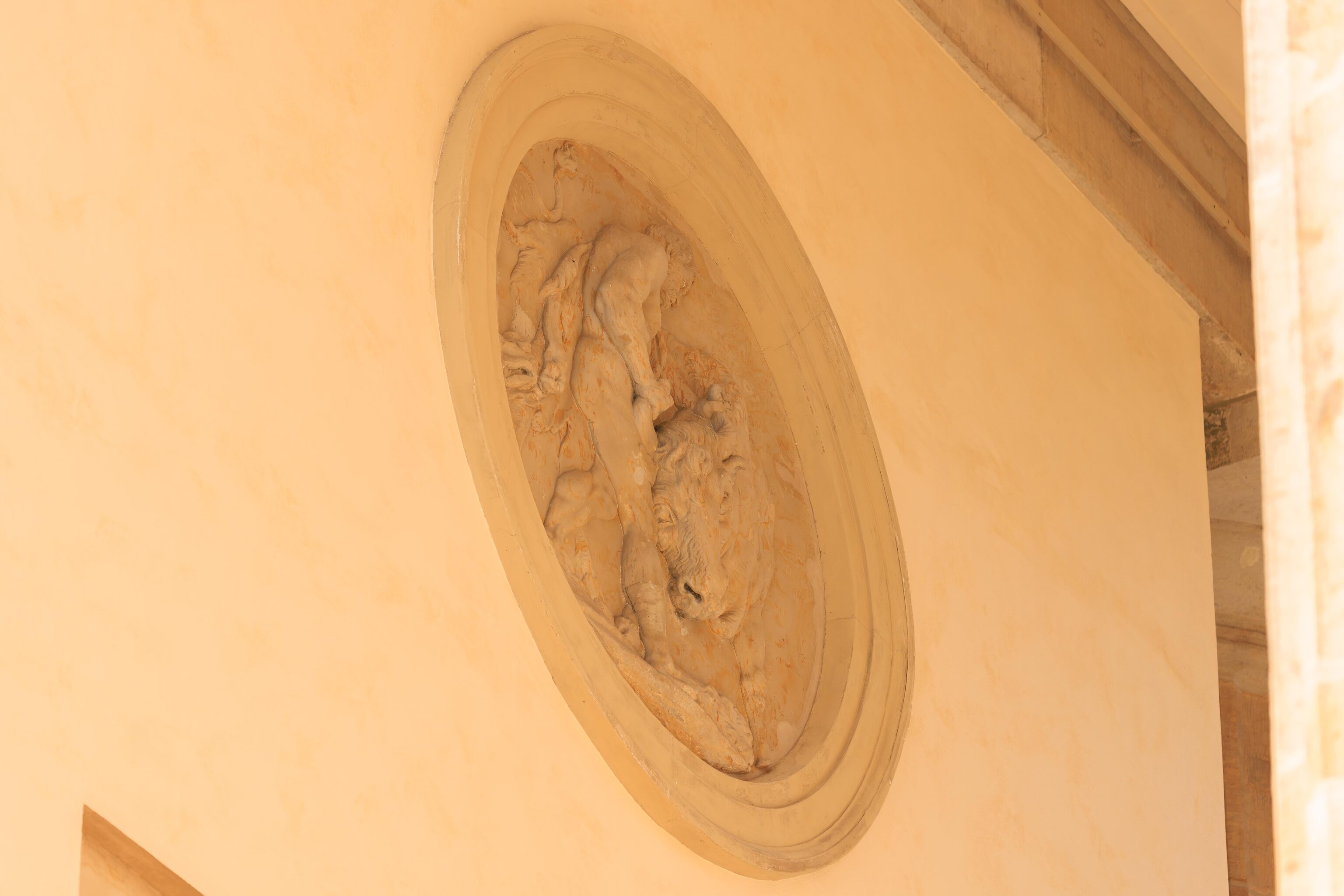
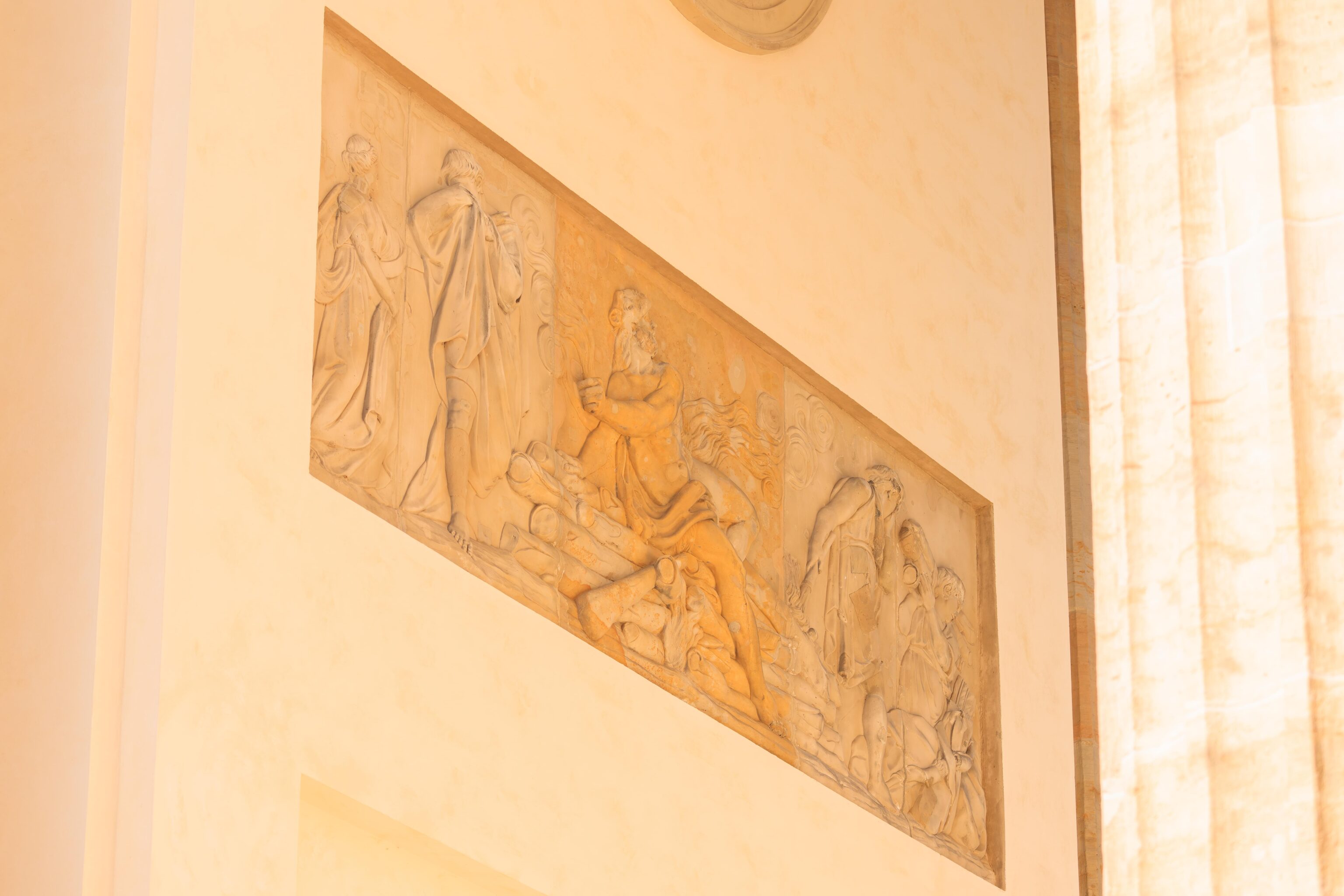

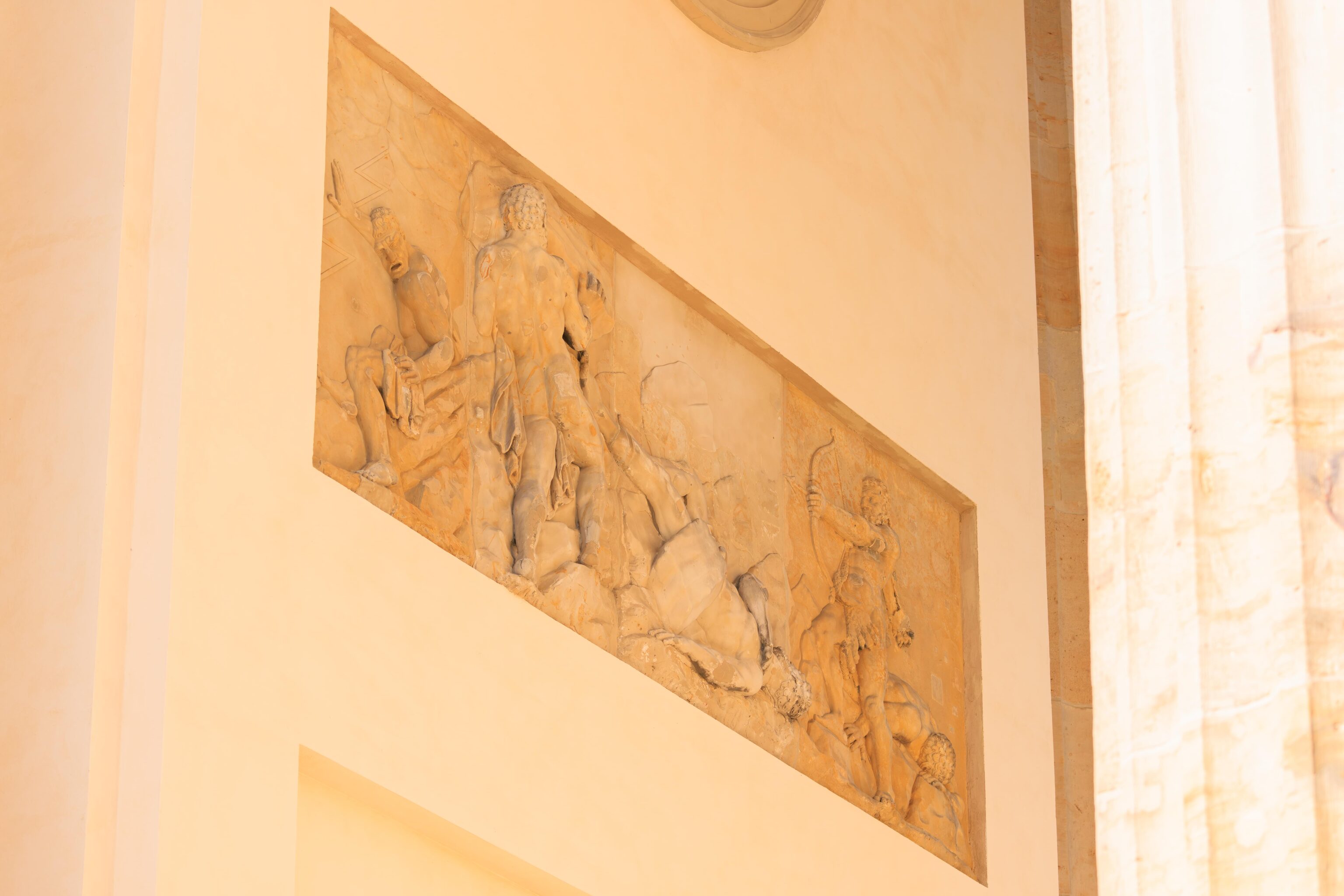






The north facing reliefs, from north to south.
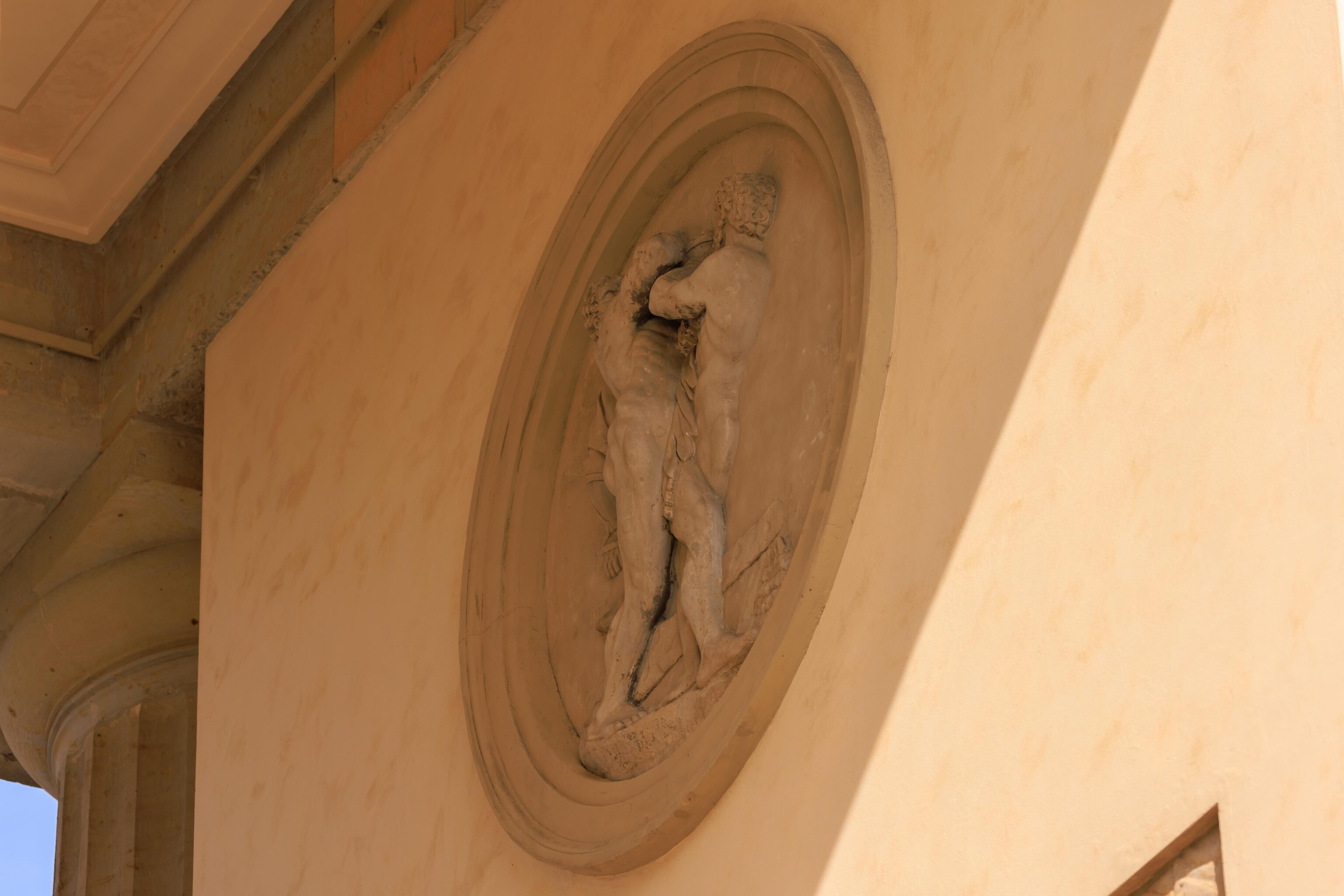
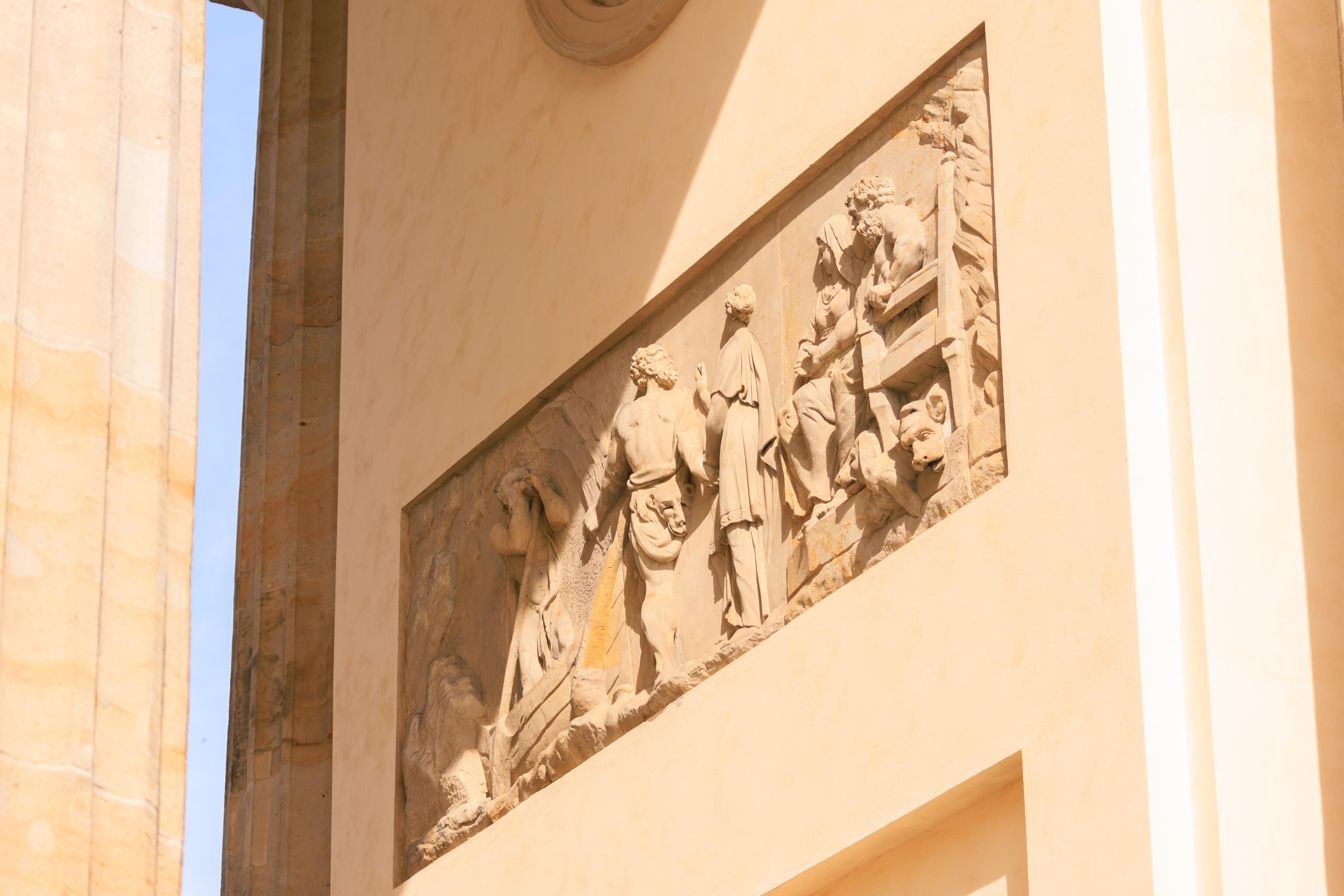


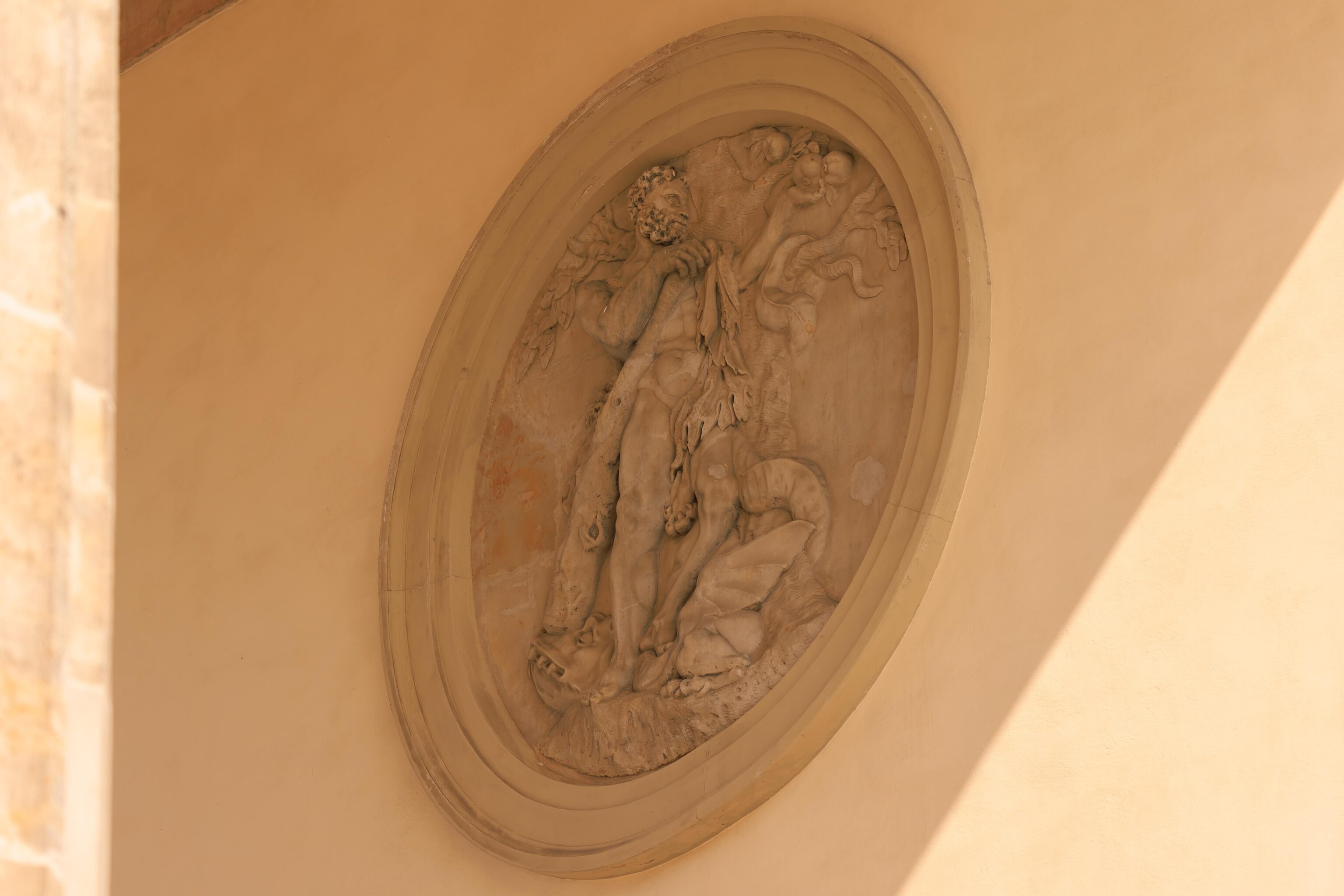

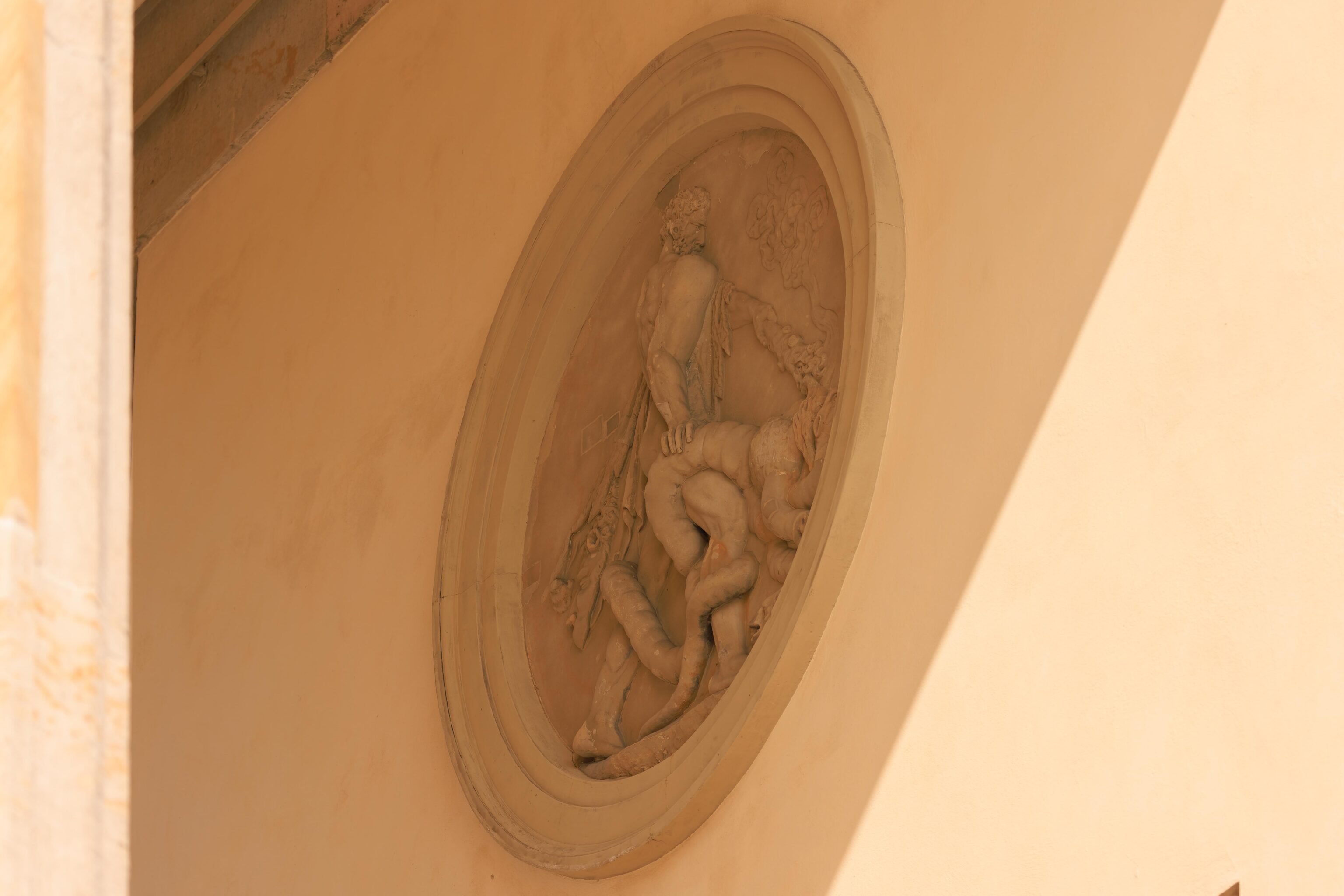
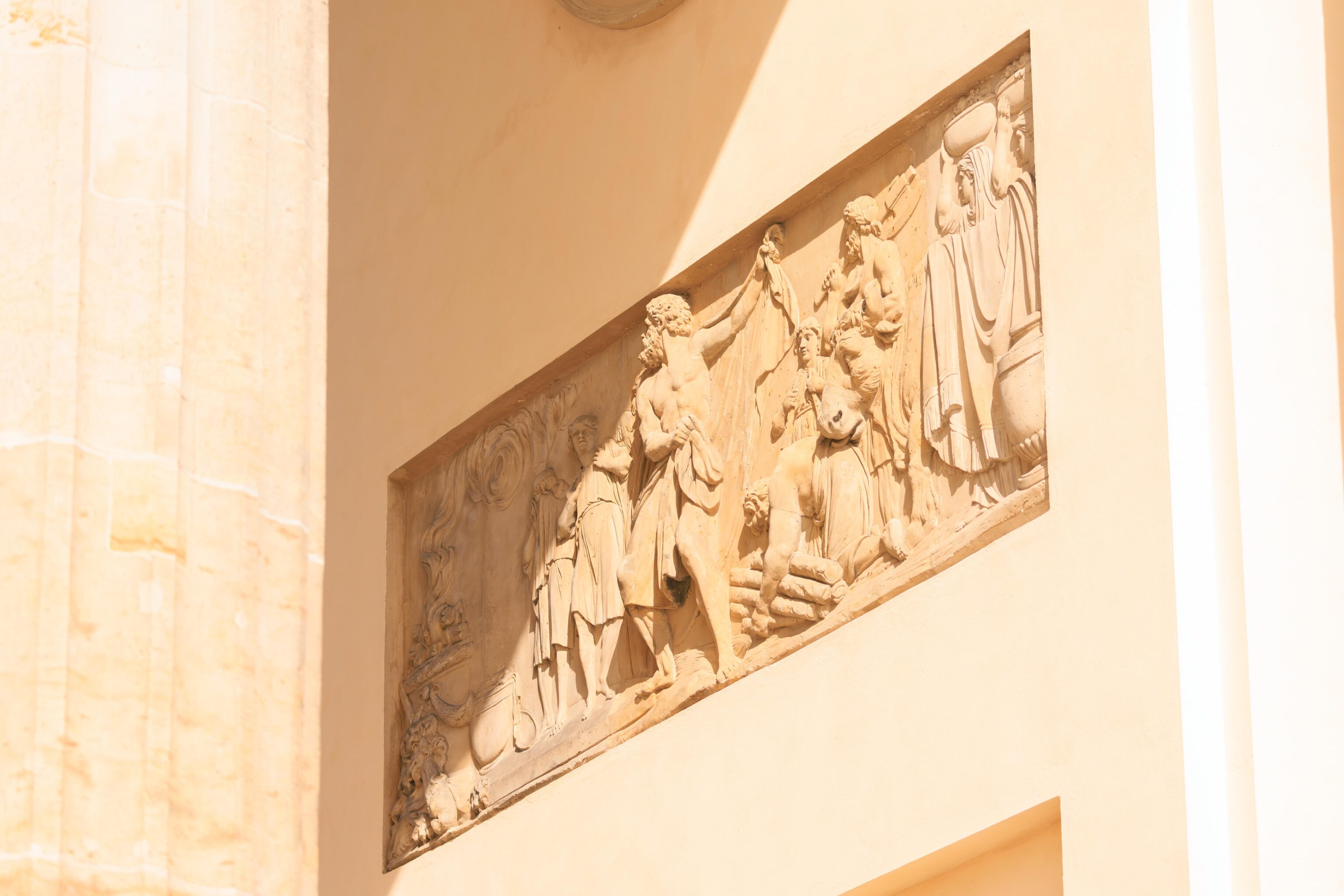

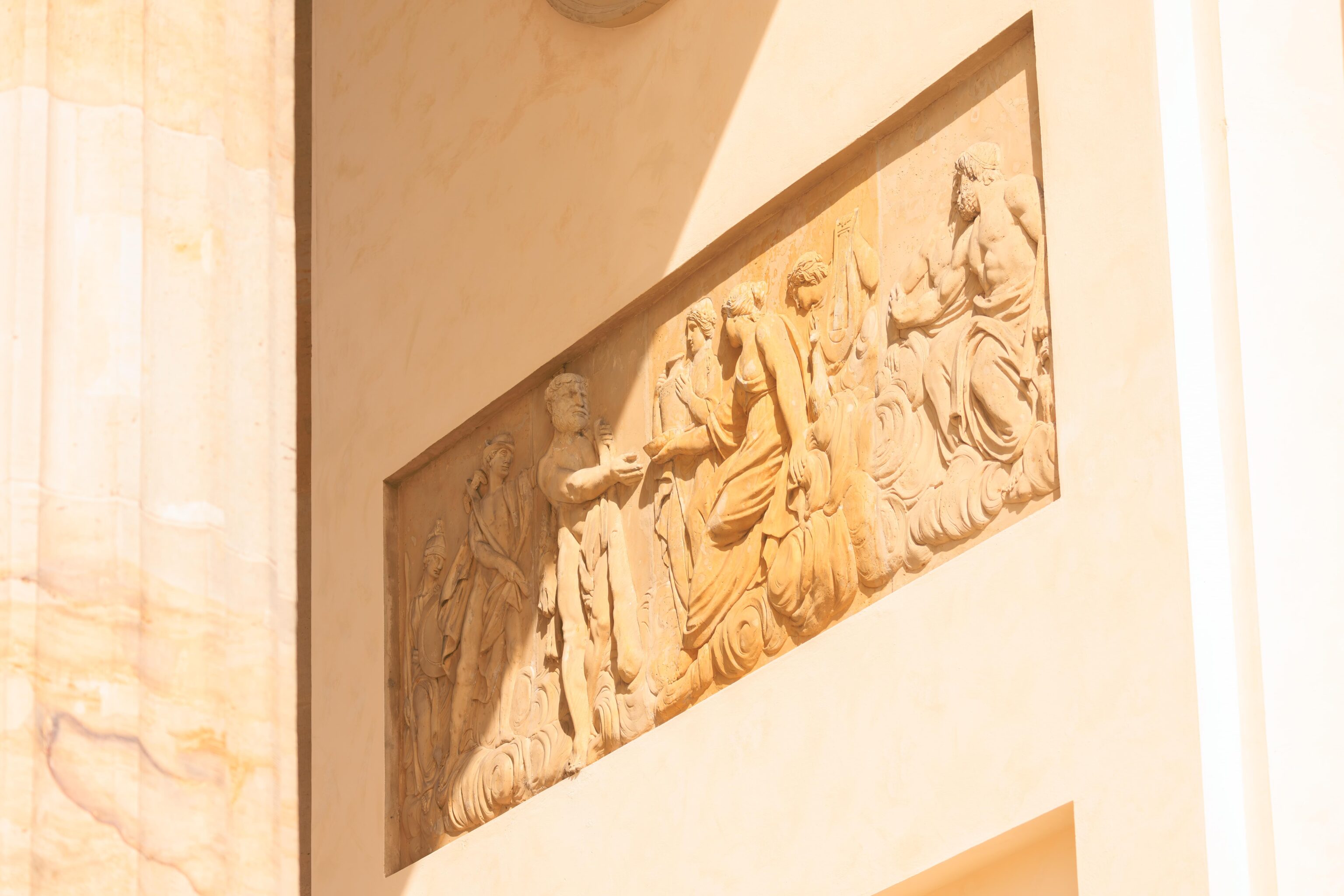
The south facing reliefs, from south to north.
Britannica, the former encyclopedia publisher, has a Brandenburg Gate article which briefly describes these reliefs:
The gate is decorated with reliefs and sculptures designed by Gottfried Schadow, the majority of them based on the exploits of Heracles.


The exterior side of the northern and southern walls hold sculptures.
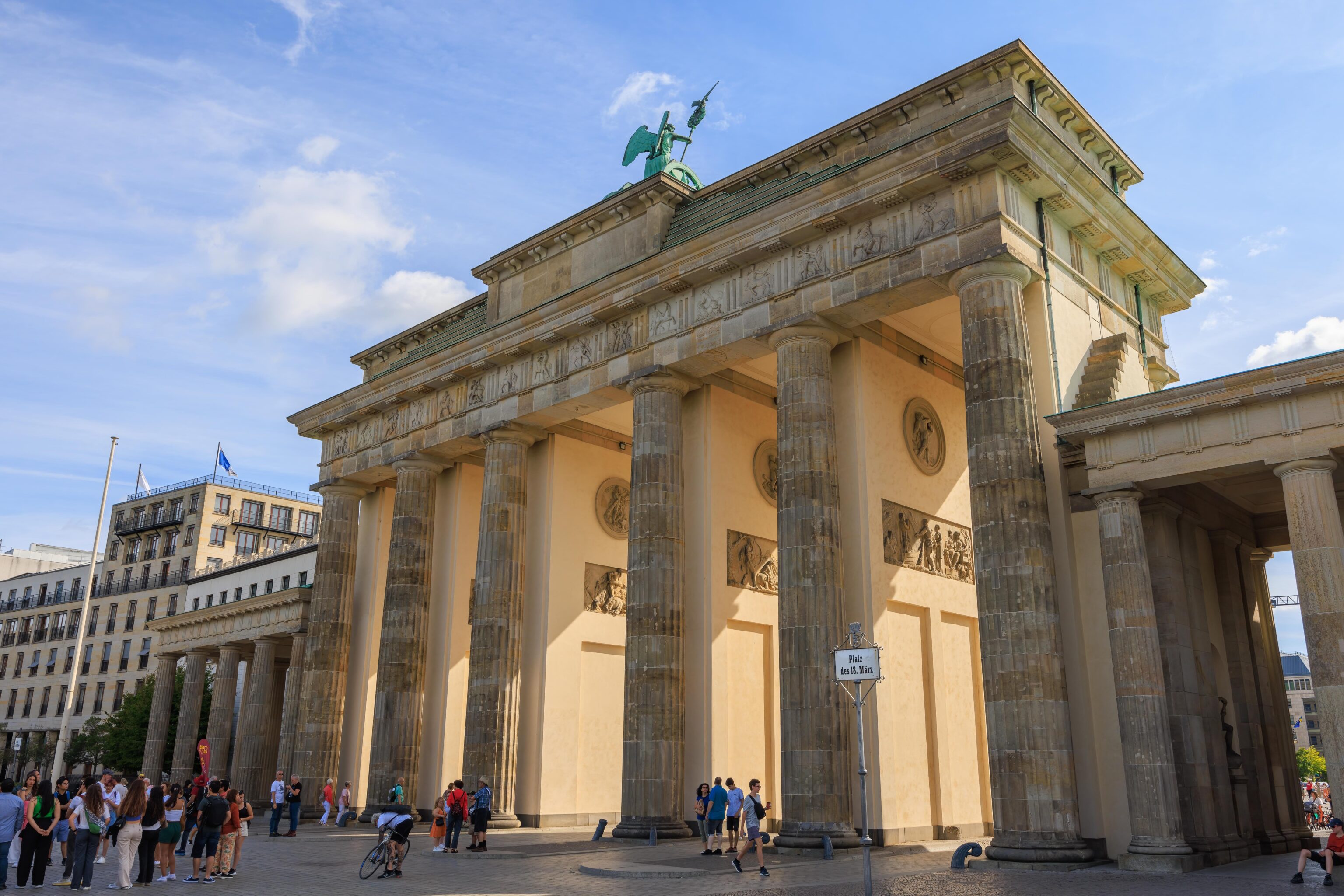
The gate from the west side.

The Reichstag building, home of the Bundestag (Federal Parliament), is visible from the west side of the gate.

The Victory Column looks bigger with the aid of a telephoto lens! The statue in the foreground on the left is Der Rufer (The Crier). Berlin’s state website has a description:
“I wander through the world and cry ‘Peace, peace, peace.’” This quotation from the Italian poet Francesco Petrarch is inscribed on the base of the sculpture “Der Rufer,” which stands on the Strasse des 17. Juni. This bronze is 3 meters tall and was created by the sculptor and graphic artist Gerhard Marcks in 1966. Along with Wilhelm Lehmbruck and Ernst Barlach, Marcks is considered one of Germany’s most important twentieth-century sculptors. In May 1989, just a few months before the fall of the Wall, a private foundation purchased a casting of this artwork with the intention of putting it up on Strasse des 17. Juni in West Berlin. Other castings of the “Der Rufer” have been erected in various places around the world. Marcks never committed himself to a particular interpretation of his sculpture; while Berlin read its message as a call for peace, the sculpture put up in Perth, Australia, was dedicated to victims of torture. The original sculpture was made for Radio Bremen.
To the Reichstag
We did not walk towards the Victory Column and the statue. Instead, we took a diagonal path to the northwest into northeastern corner of the Tiergarten.
Tiergarten translates literally to Animal Garden in English and can also mean zoo. This term has been confusing as there are various places referred to as a Tiergarten but are clearly not zoos. The Tiergarten does actually contain a zoo in the southwest corner named Zoologischer Garten Berlin. The Tiergarten was formerly a royal hunting ground, this giving it its name. The formal name of the park is actually Großer Tiergarten (Greater Animal Garden).

We came across the Memorial to the Sinti and Roma of Europe Murdered under National Socialism. The glass wall presents a timeline in both German and English. The memorial’s website has a paragraph from the architect:
A clearing in the Tiergarten, lined with trees and bushes, near the Reichstag building. A small, inconspicuous place, which avoids the noise of the big city. A place of inner sympathy, a place to feel the pain, to remember and never let the destruction of the Sinti and Roma by the National Socialist regime fall into oblivion. Is such a place even possible? Is the possible the emptiness, the nothingness? Do I have the power within me to create a place of nothingness? Where there’s nothing. No words, no names, no metal, no stone. Only tears, only water, surrounded by the survivors, by those who remember what happened, by those who know horror and others who did not know it. They are all reflected here, standing on their heads, in the water of the deep, black pit, while the sky covers them – the water, the tears. Just a single little stone that sinks and rises, again and again, day after day. And on it every day a new little blossom to remember, to recall each time anew, incessantly, for all eternity. The water surrounds the sky, the blue sky, the grey sky, the black sky. The clouds, the light, the darkness. Everything is swallowed up by the swirling water. Only the sound of a lonely violin has remained of the murdered melody, floating in pain.

The memorial, on the other side of the glass wall, consists of a pool of water surrounded by stone tiles. Some stone tiles have place names written on them. While many of the locations are unfamiliar, there are others that are. These are the locations of concentration camps and other similar sites where the Sinti and Roma were murdered.
The south side of the Reichstag can be seen from a gap in the trees around the memorial.

We continued on the path until we reached the southwest corner of the Reichstag. It is possible to visit the building and its modern glass dome but advance ticket purchase is required, up to 2 to 3 weeks in advance based on what we saw on the website.

There is a memorial by the visitor security checkpoint. This is the Memorial to the Murdered Members of the Reichstag and lists their name, birth and death dates, place of death, and party. They all died as a result of the Nazis.
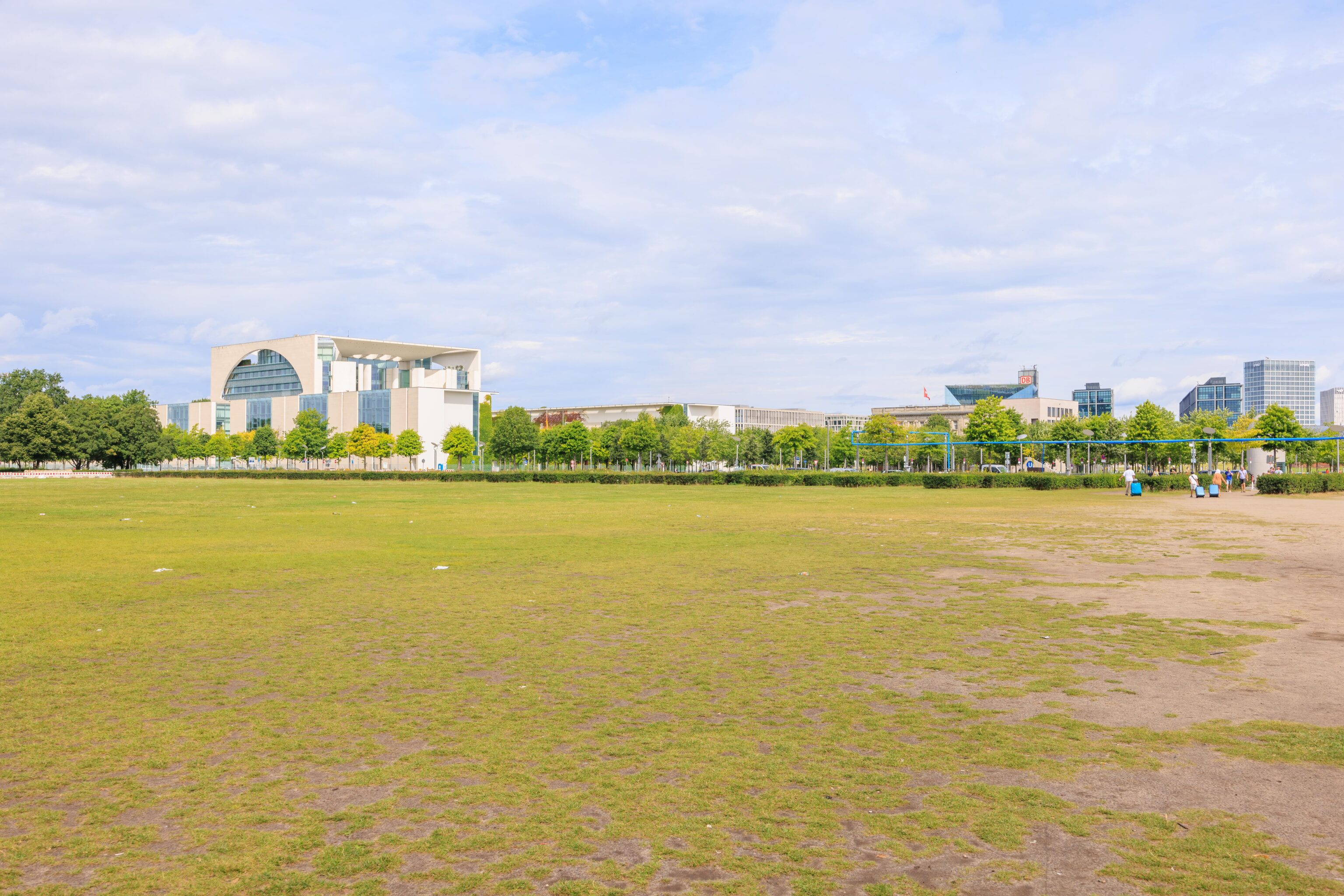
There is a large open field to the west of the Reichstag. At the time, we didn’t realize the significance of the buildings in the background. The large modern building on the left is the Bundeskanzleramt (German Chancellery). It is both the office and residence of the chancellor. The chancellor seems to be something like a Prime Minister.
Großer Tiergarten
If we had known what the building was, we probably would have went for a closer look. But instead we headed southwest back into the Tiergarten.

After a short distance, we could see our next destination ahead beyond the trees.
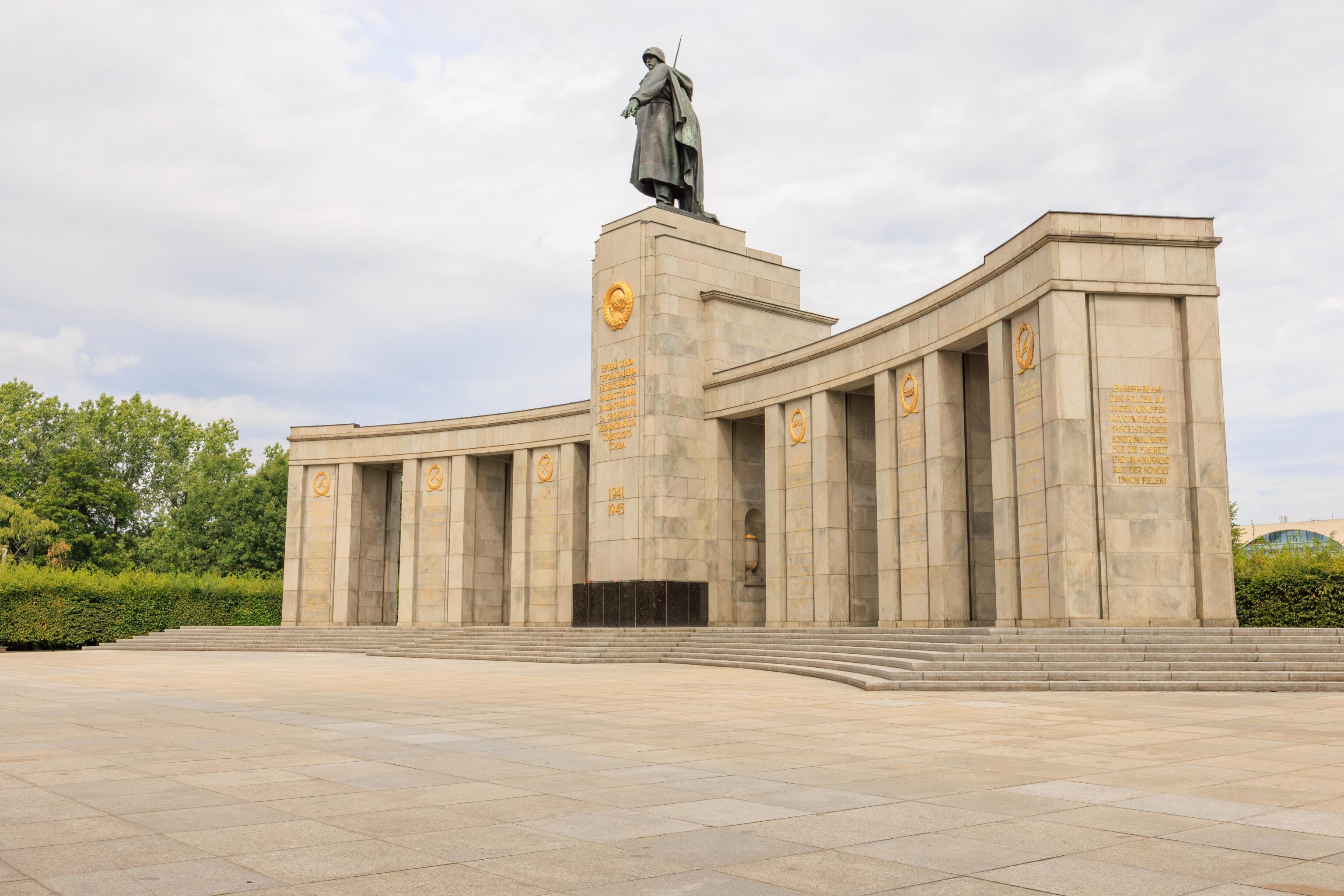
This is the Sowjetisches Ehrenmal (Soviet Memorial, though Ehrenmal translates to Cenotaph). This memorial commemorates the Soviet soldiers who fought to take Berlin. Interestingly, this memorial is in West Berlin in the British Zone. Today, it continues to be maintained as a result of the treaty between East and West Germany that reunified the country.
The monument was built in 1945, not long after the war in Europe ended. The Soviets had taken Berlin which seems to be the likely reason why the monument is in what was to become West Berlin as the city had not yet been partitioned, it was all under Soviet control.
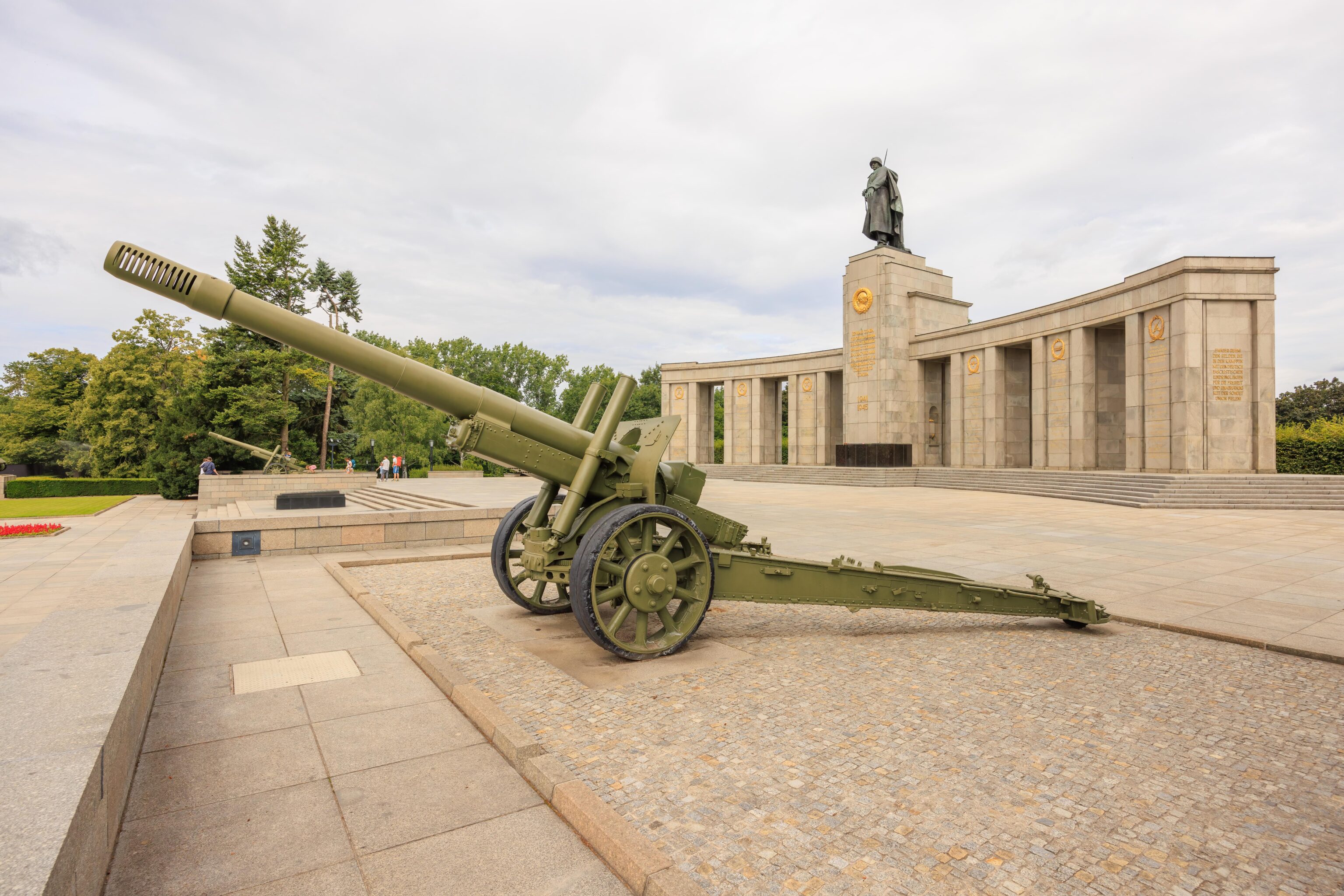
There were two artillery pieces on either side of the monument.
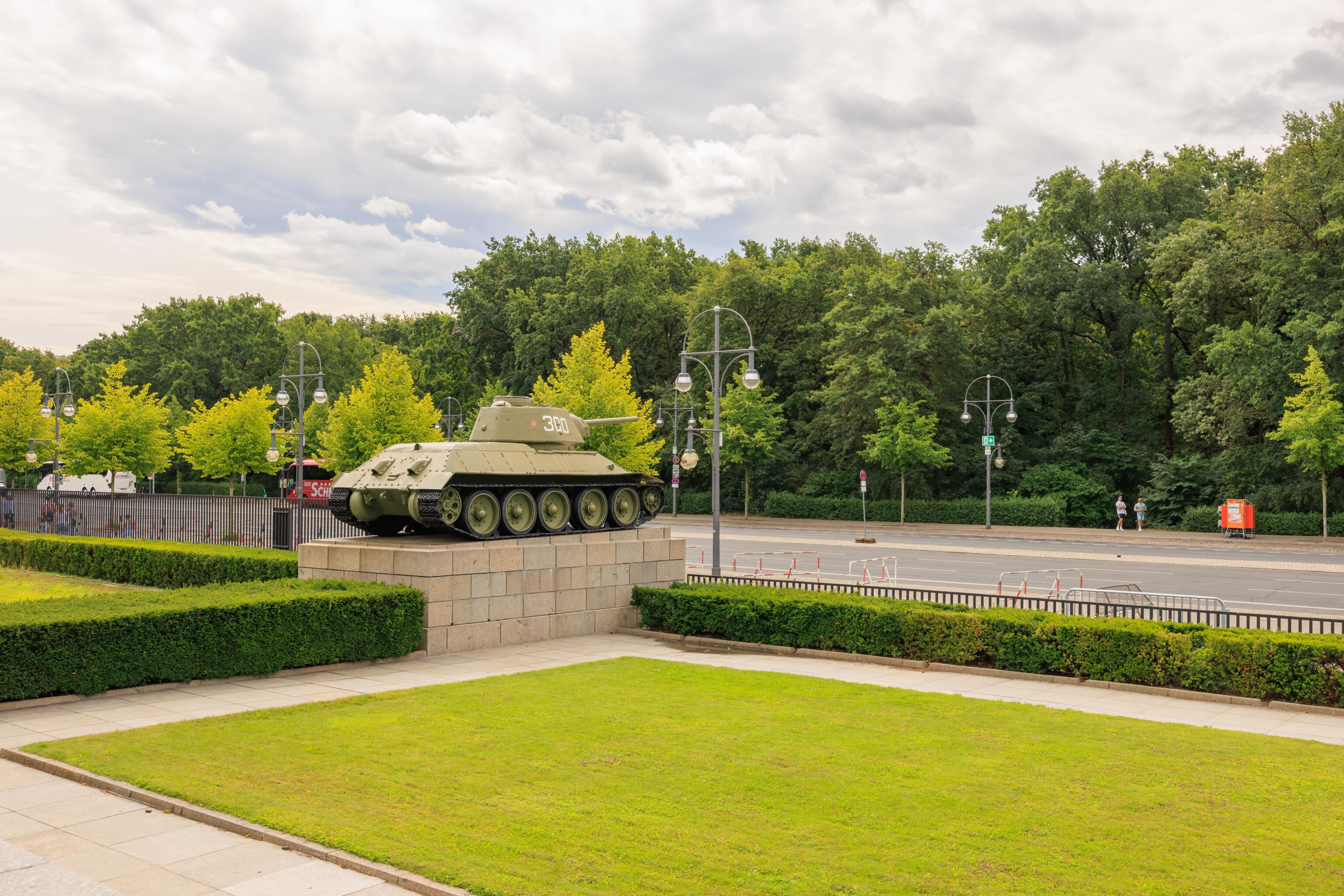
And there are two tanks further away by the road, which is the road that would run through the Brandenburger Tor if there wasn’t a plaza there instead.

Other than the little red star on the tanks, the hammer and sickle, and some other minor details, it seems very much like a monument that we would build in the US.

The monument from the side, showing the solder standing atop it.

We crossed the street to head to the south. The Brandenburger Tor looks small from this distance. The Der Rufer statue is there too, though it is somewhat blocked by a sign.
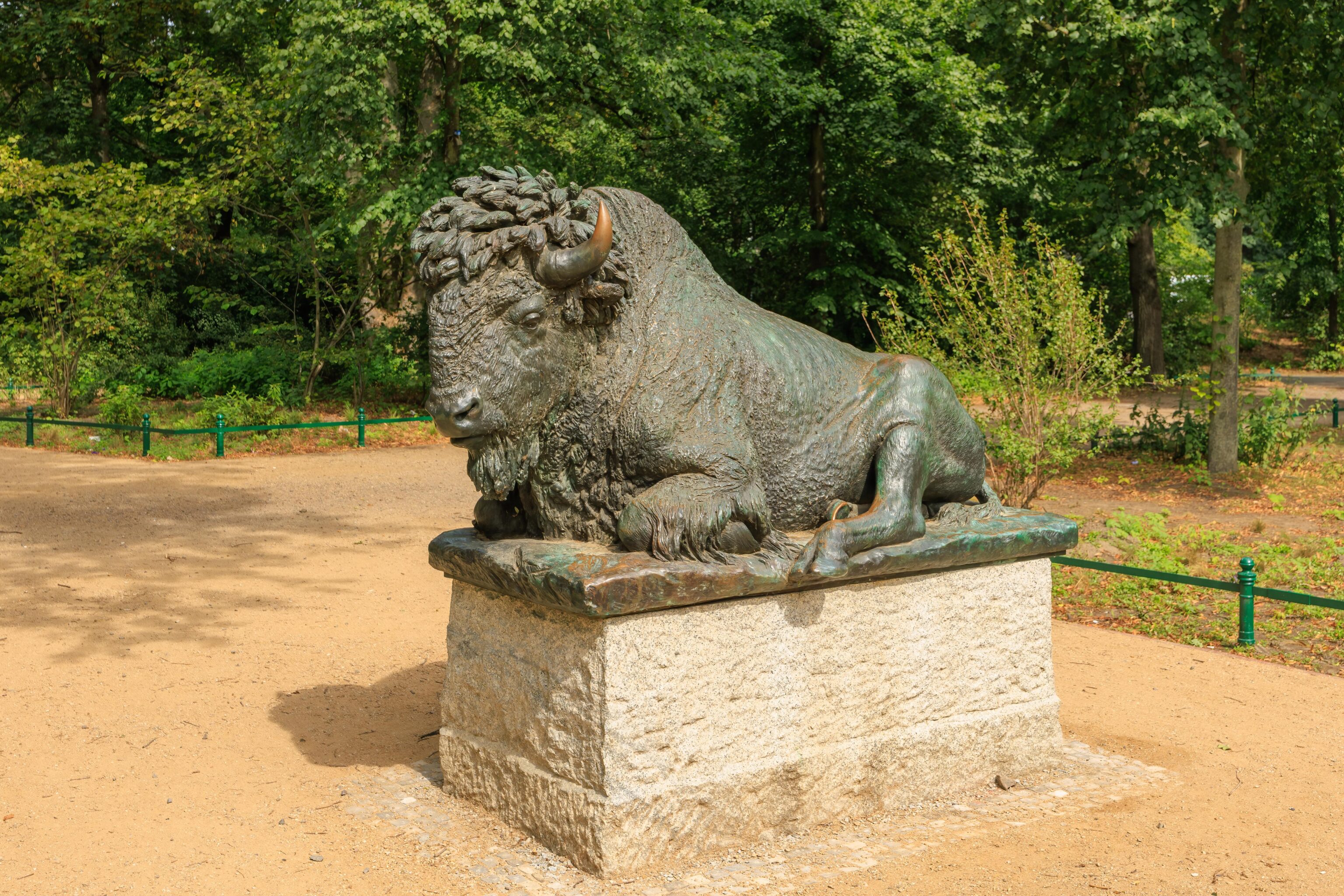
This section of the Tiergarten has animal sculptures. We didn’t really try to take a look at them but did notice this one as we walked by. It seems to be a Bison.
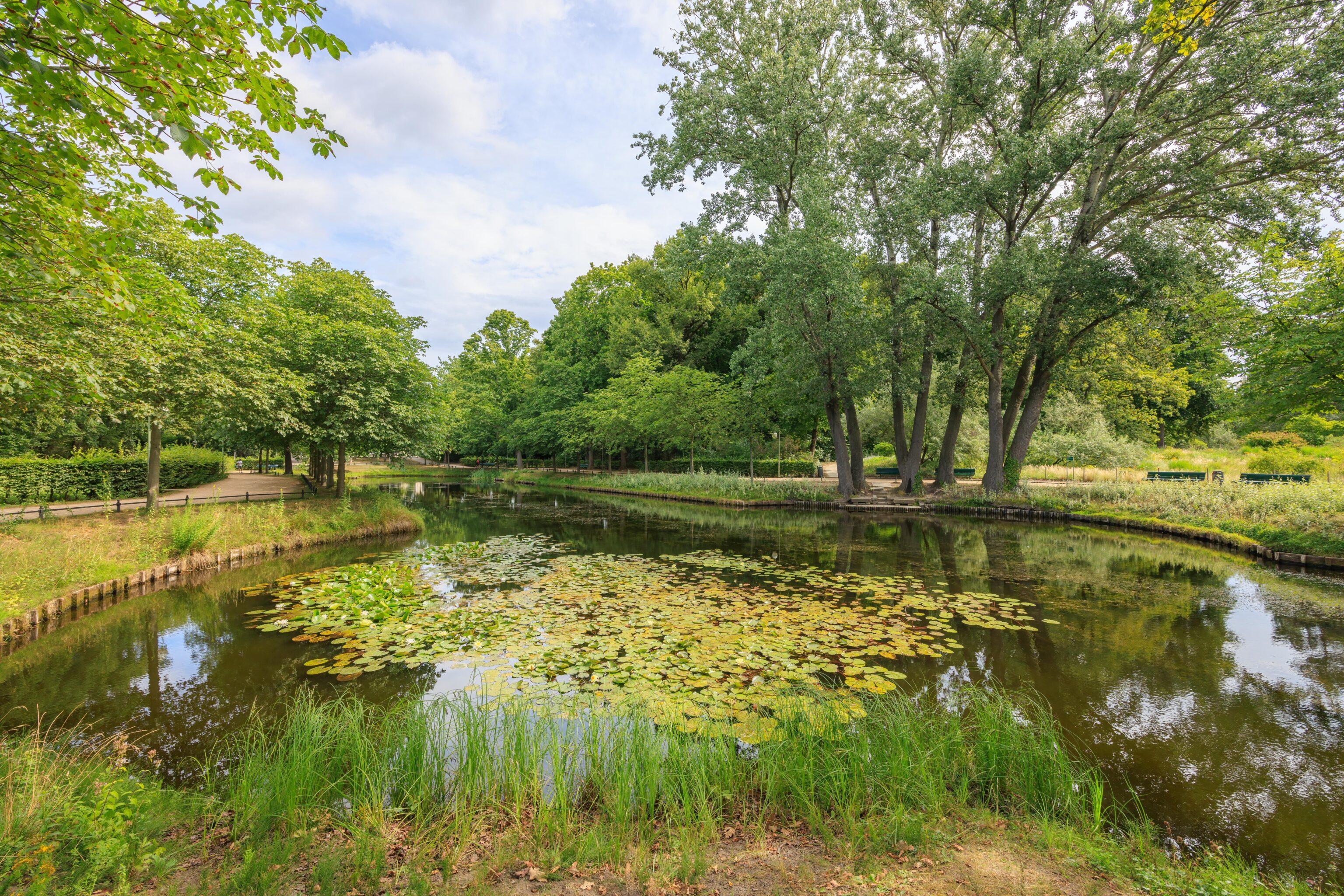
There was a long pond just to the east of the animal statues. It is marked as the Goldfischteich (Goldfish Pond) on Google Maps.
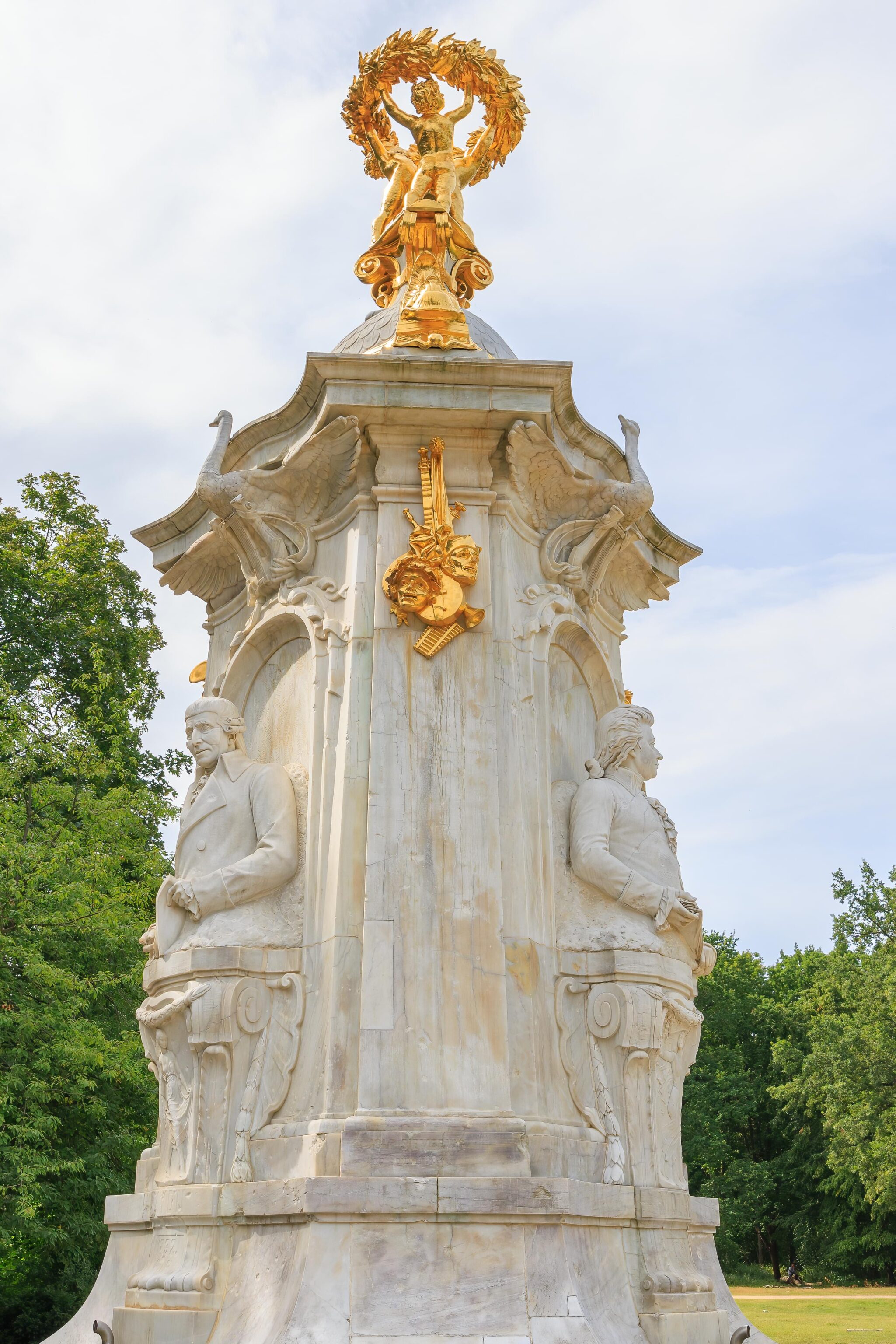

This memorial is at the southern end of the pond. It is the Beethoven-Haydn-Mozart-Denkmal. There are figures of the 3 famous composers on the sides.
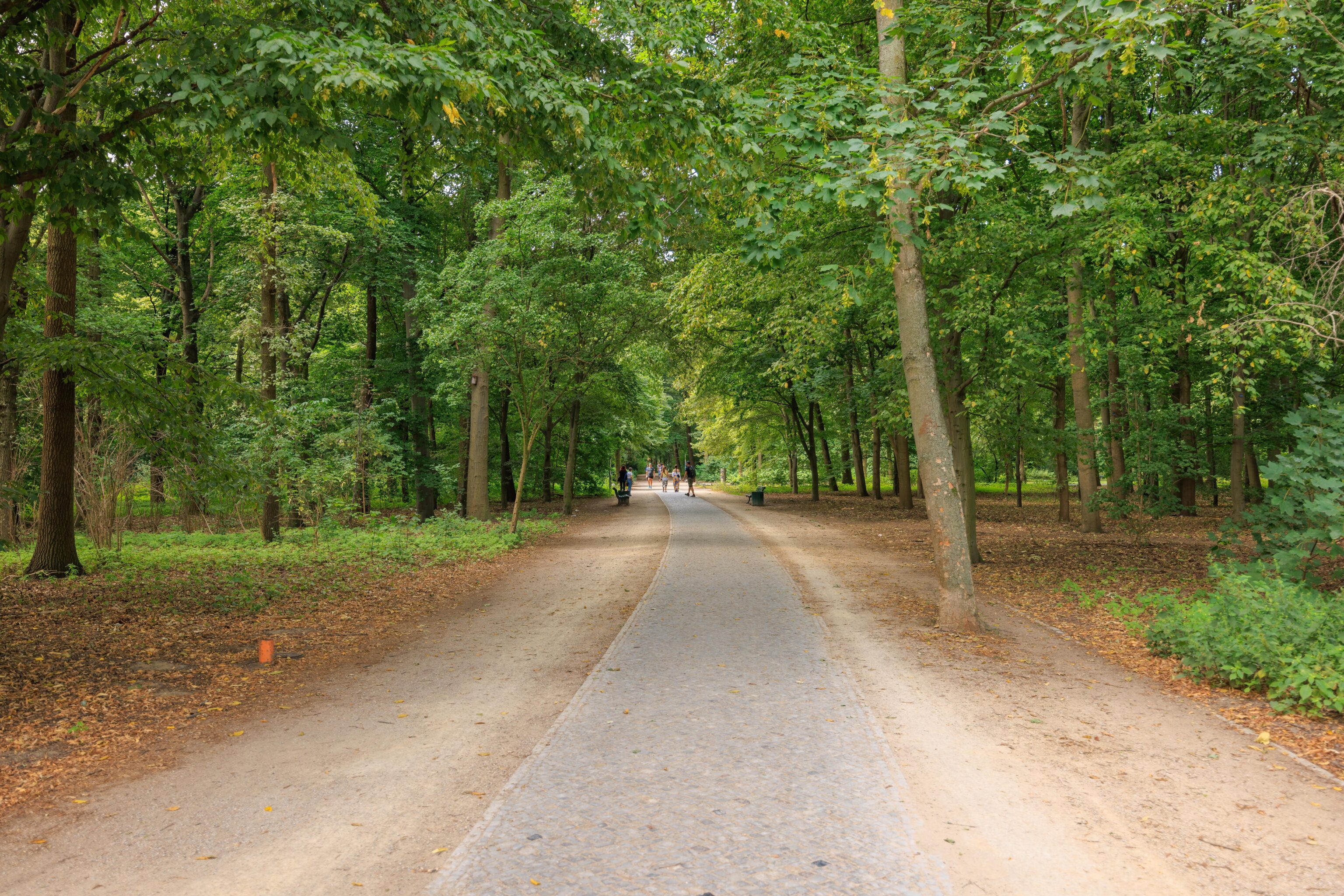
We continued to walk south until we reached this wide path. From here, we walked to the west.

We passed by this long gap in the trees with paths on either side. This is an extension of the Bellevuestraße and runs straight through the Tiergarten.

After a little bit of walking, we reached this statue on the Luiseninsel (Louise Island). The statue is of Queen Louise, wife of King Frederick William III.

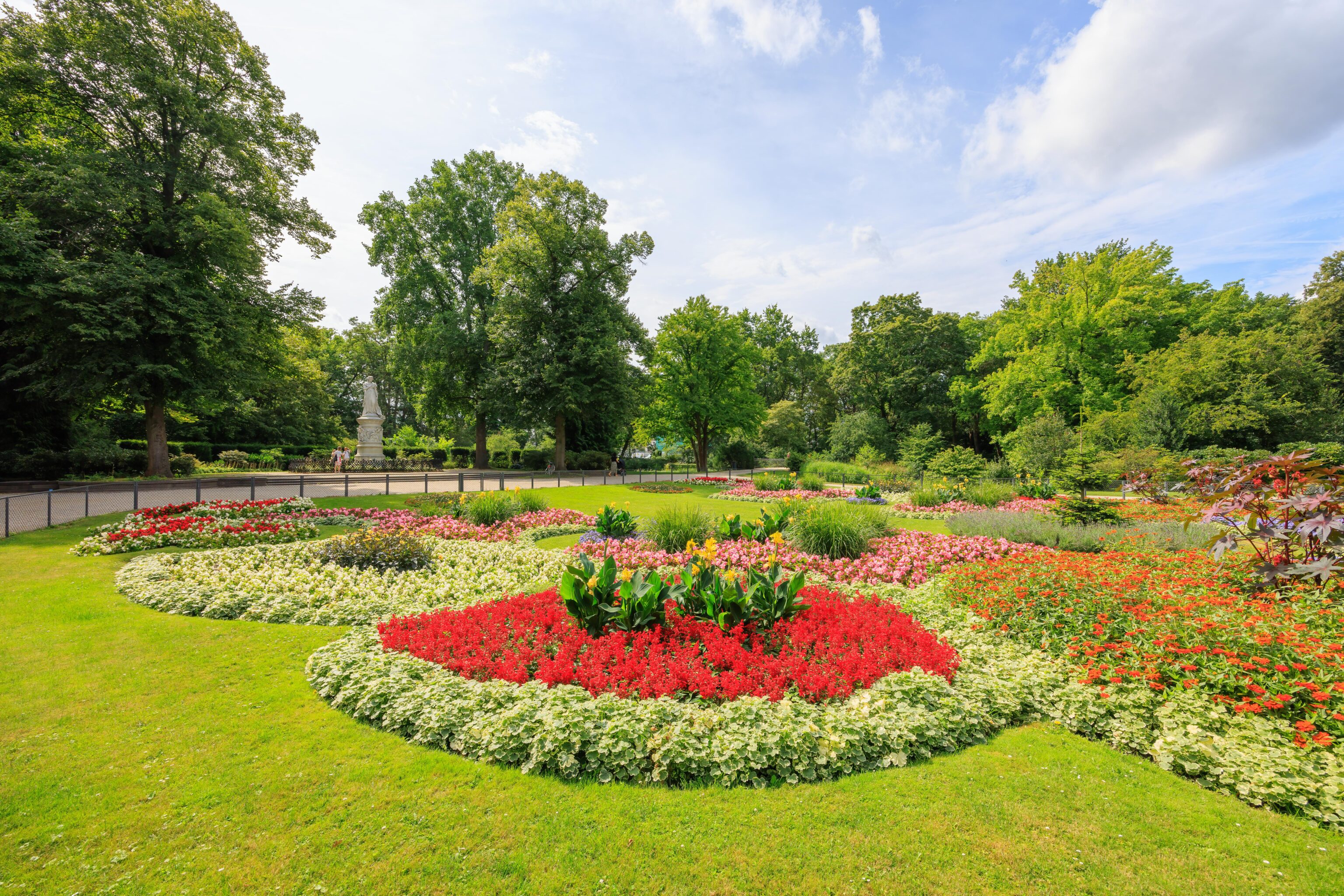
The island contains a small garden with many flowers.


The island is surrounded with green foliage and seems as if it is in the wilderness.

We exited the island from a bridge on the north side and walked to the northwest. We came across this statue of someone we didn’t recognize in a small open area lined with benches. It is Albert Lortzing. He doesn’t seem to be well known outside of Germany.

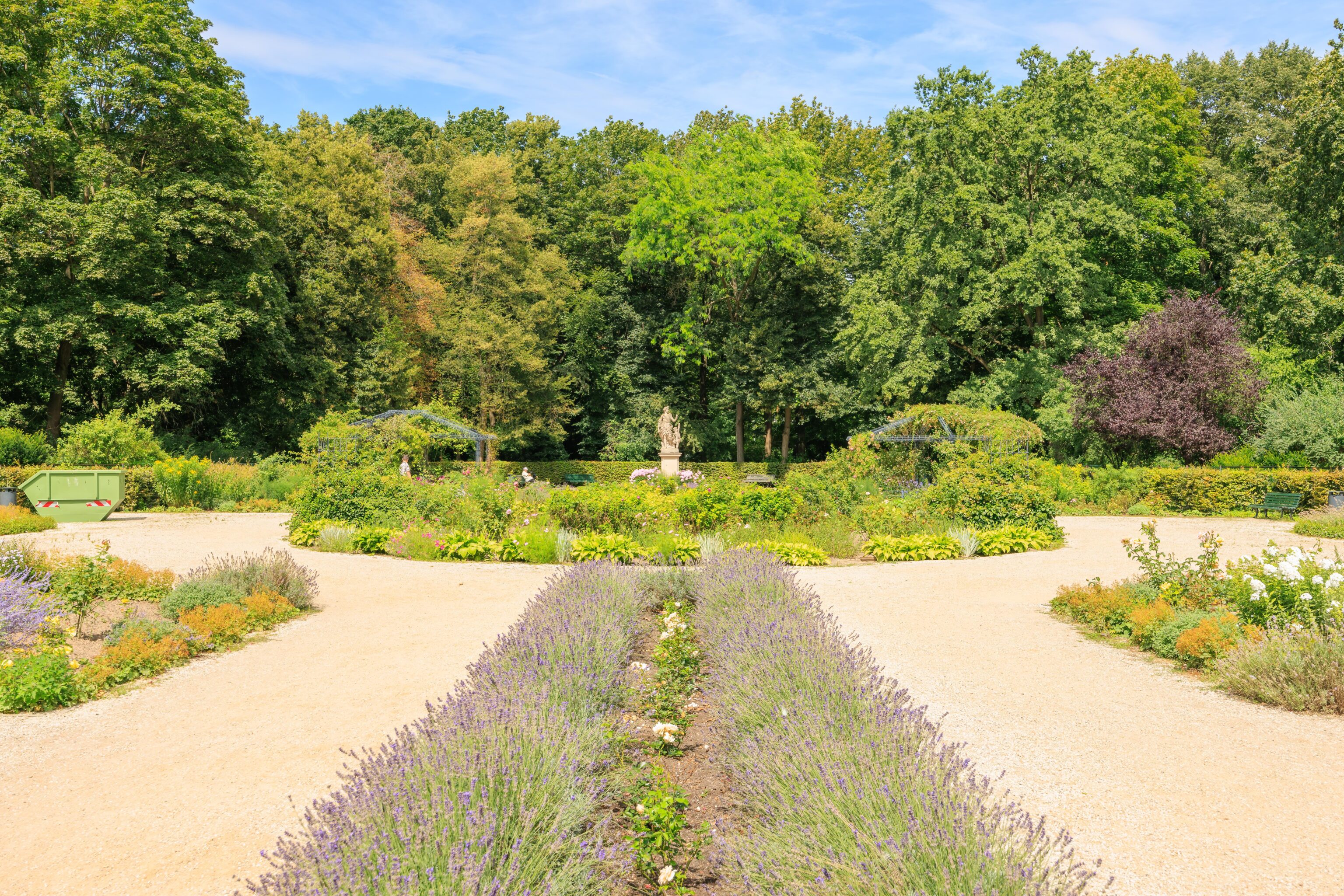

We soon ended up in another garden area, the Rosengarten (Rose Garden).

There wasn’t any shade in most of this garden. But there were little pavilions which provided seating a bit of shade from the sun.
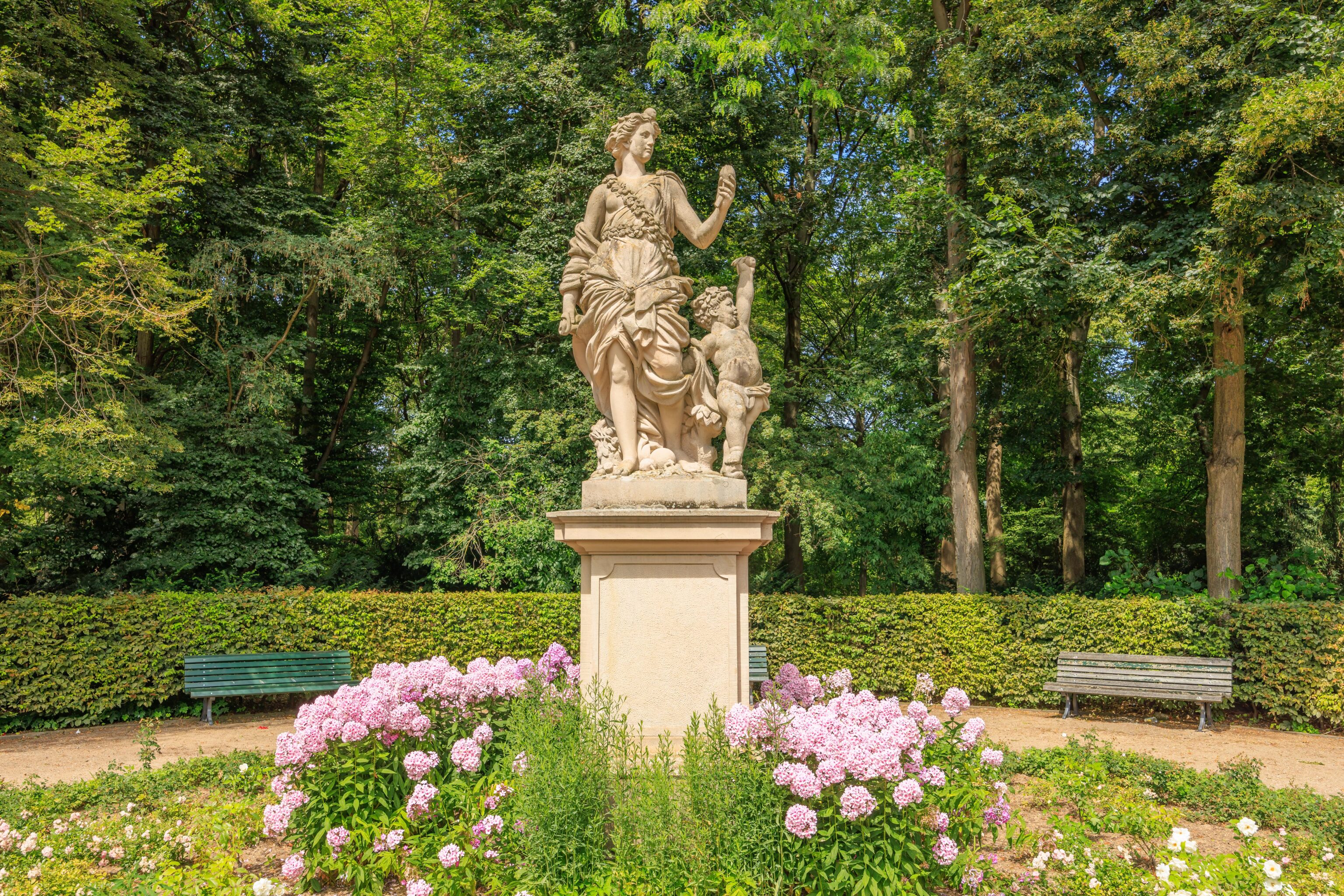
This statue, Flora, stands at the northwestern end of the Rosengarten. This statue is a copy of the original from the late 18th century. The Berliner Morgenpost has an article about the history of this statue.

We continued walking, finally reaching the Siegessäule! The statue faces away from the Brandenburger Tor. Unfortunately, this means we were seeing it from behind.

We walked to the north side where we could get a better view. The lighting was not as good from this angle though as it was backlit by the sun.
It is possible to go up to the base of the statue, though we did not.

We passed by this statue on the north side of the Siegessäule. It is Helmuth von Moltke the Elder, a person that we hadn’t heard of before. It is extremely hard to see but there is an ornate coat of arms underneath Moltke’s name with what seems like a trio of ducks! The coat of arms is described in an excerpt from Blood and Iron, a book about the von Moltke family:
a shield showing three male black grouse and a helmet surmounted by six peacock feathers
So they’re not ducks. And interestingly, the book excerpt is on The Washington Post’s website. Anyhow, he was the Chief of the German General Staff, which seems to imply head of the German military, during the late 1800s.

This much larger memorial was nearby. This is Otto von Bismarck, the first chancellor of the German Empire. This seems to mean the first chancellor of a unified Germany.

There is more on the back of the statue.

From the back of the memorial, we headed to the northeast. We stopped in front of this grand residence, the Schloss Bellevue (Bellevue Palace). We were a bit confused at the time and thought this was the German chancellor’s residence. It is not.
It is the official residence of the German president. So, we learned that Germany has a president. The president seems to perform the role of the monarchy in a country which no longer has a monarchy and is elected by the Federal Convention. Confusing. But then again, we have the Electoral Collage in the US so maybe this system isn’t so too confusing at all!
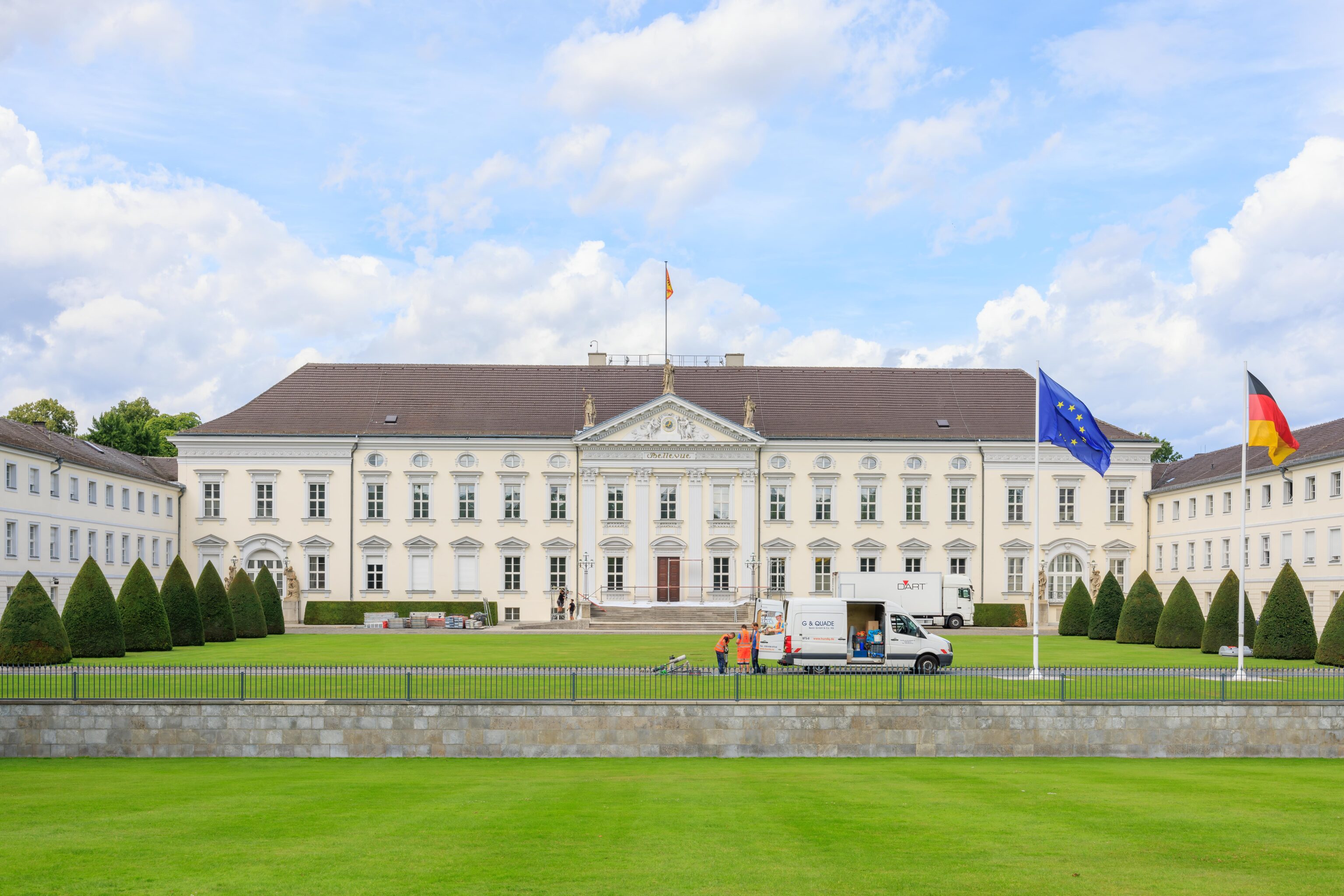
The view of the building was marred a bit by the construction crew.
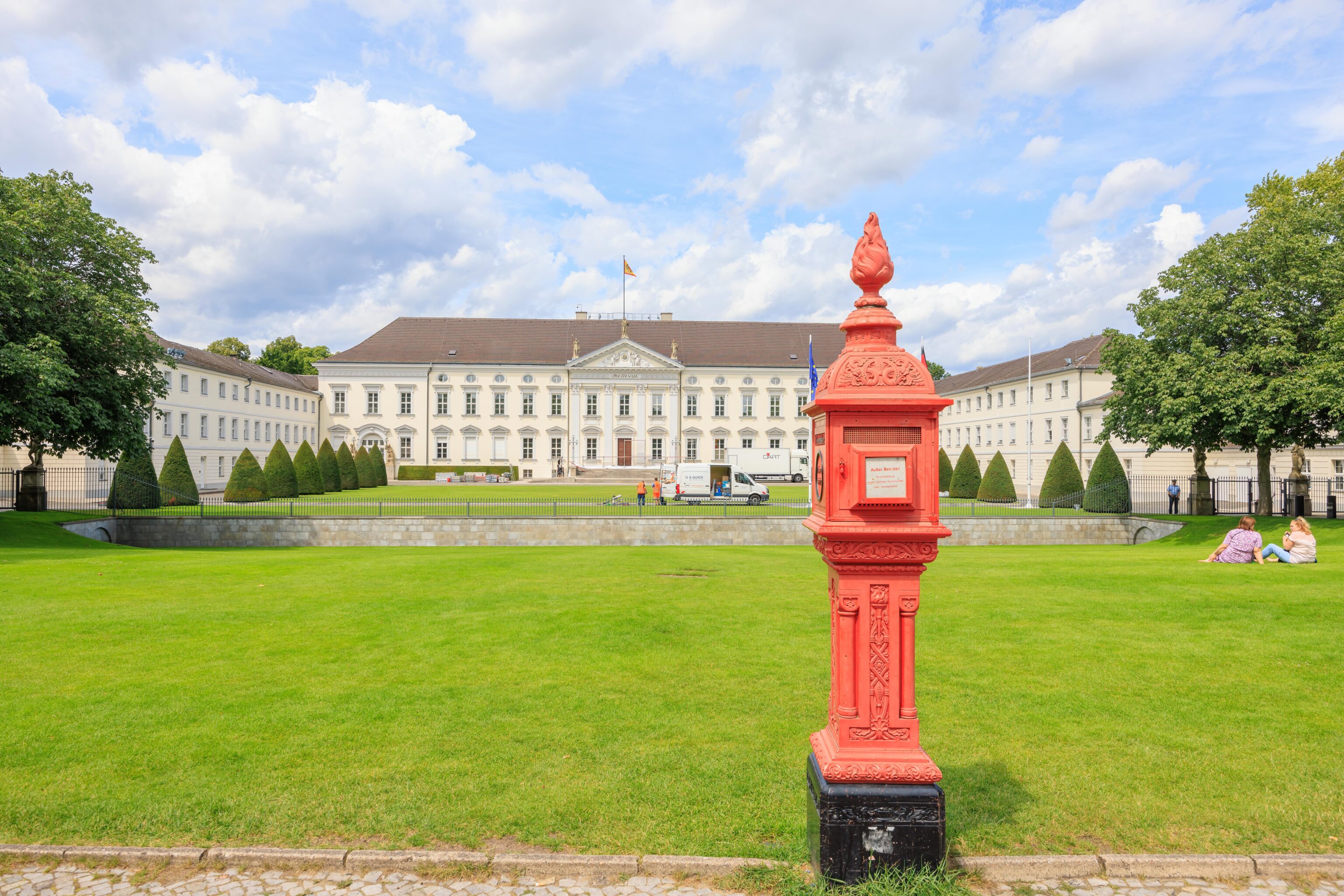
This red thing is apparently a historic fire alarm box. Atlas Obscura has a short entry about these boxes.

We decided to head next to the Bellevue S-Bahn station to head for the southwest corner of the Tiergarten. We walked by the Spree to get there.

This bridge, the Lutherbrücke (Luther Bridge), crosses the Spree right by Schloss Bellevue. It was named after Martin Luther and built in 1892.

As we were walking, we noticed this tree. The metal railing runs through its trunk!

The next bridge is a train bridge. The station is on the left side, though not visible due to the trees.
South of the Zoologischer Garten
It was just a short wait for the next S-Bahn train to come. We rode two stops to the Zoologischer Garten (Zoo). This station was somewhat large with all rail services – U-Bahn, S-Bahn, regional, and long distance.
By now, we were hungry so decided to get something to eat before continuing on. We went to La Sepia, a Spanish and Portuguese restaurant, though Google Maps considers it to be Mediterranean. This ended up being the least good meal of our trip. It wasn’t bad, but everything was merely OK.

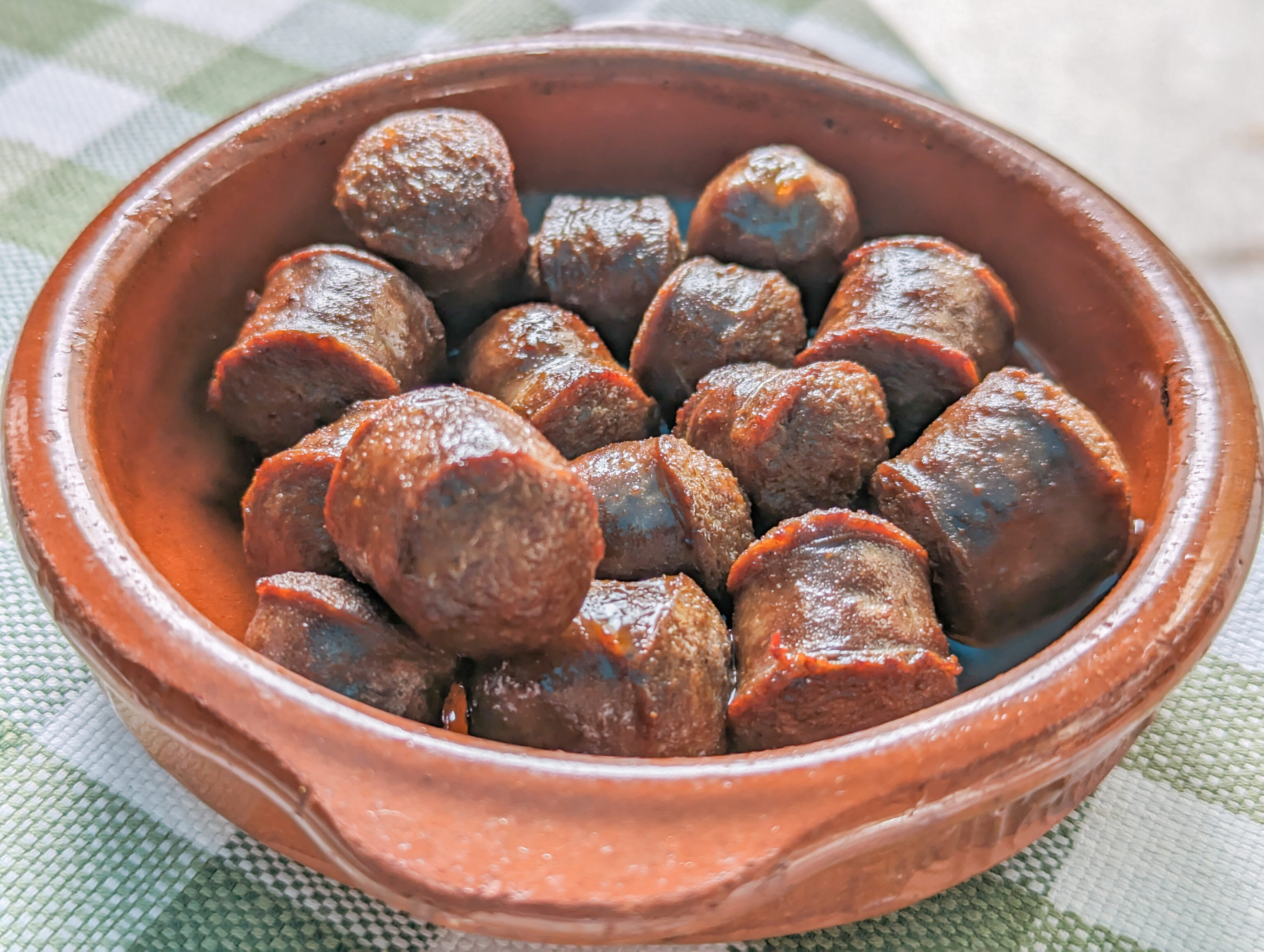
The wurst was way too salty and it wasn’t really possible to taste that it was lamb meat. It also wasn’t spicy at all, though German food isn’t spicy at all so that could be the reason. The paella was better but not at all comparable to other paellas that we’ve gotten recently in the US and UK. Though perhaps our standards have become too high for this dish.
It started raining a bit after we left but it wasn’t too bad. We put on our waterproof shells just in case though.
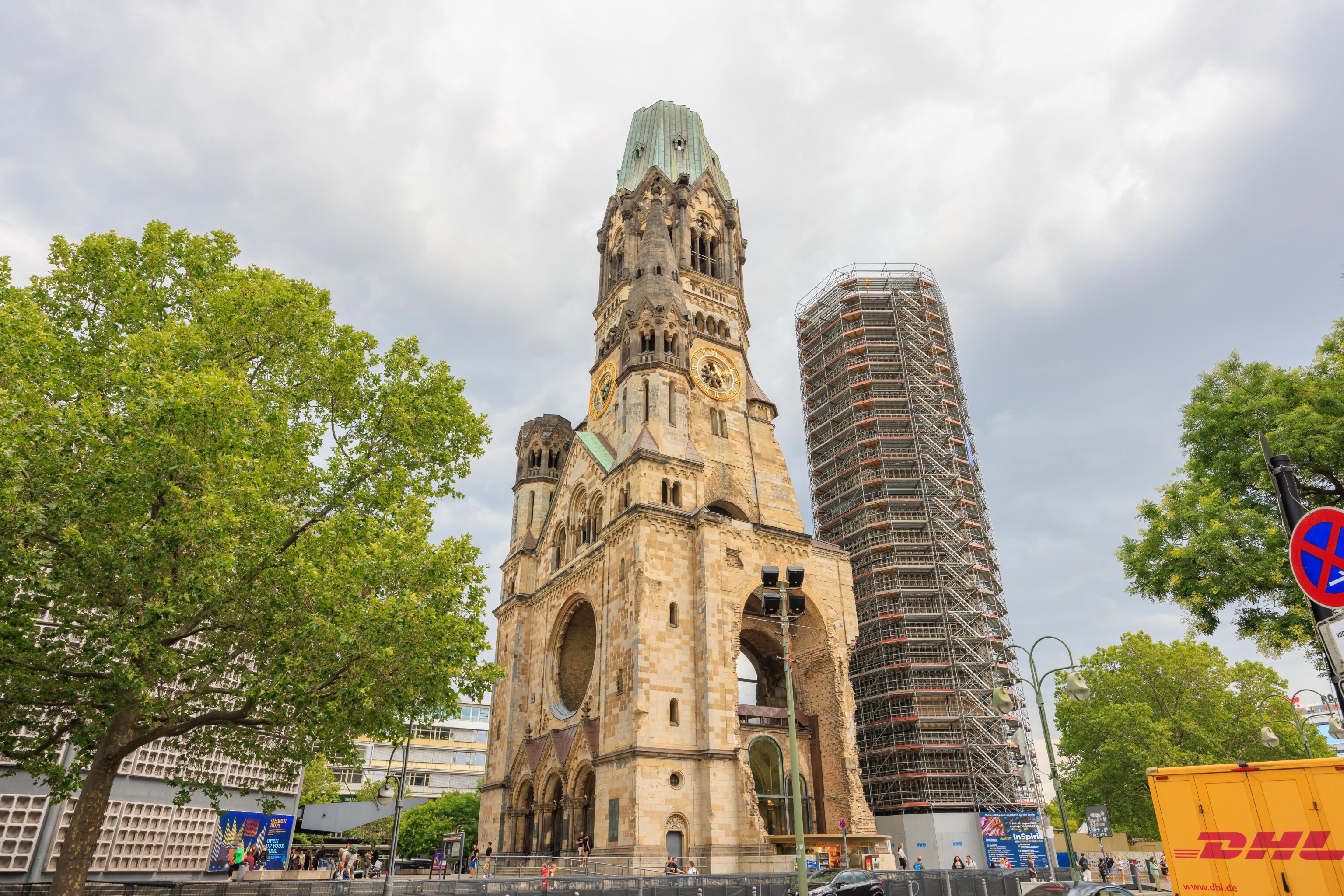
We passed by this structure on the way to La Sepia but didn’t stop at the time to take pictures as we were hungry. It is the Kaiser-Wilhelm-Gedächtniskirche (Kaiser Wilhelm Memorial Church), or at least, what is left of it. The church was severely damaged during the war. Rather than rebuild it, it was left in its damaged state and maintained as a memorial.
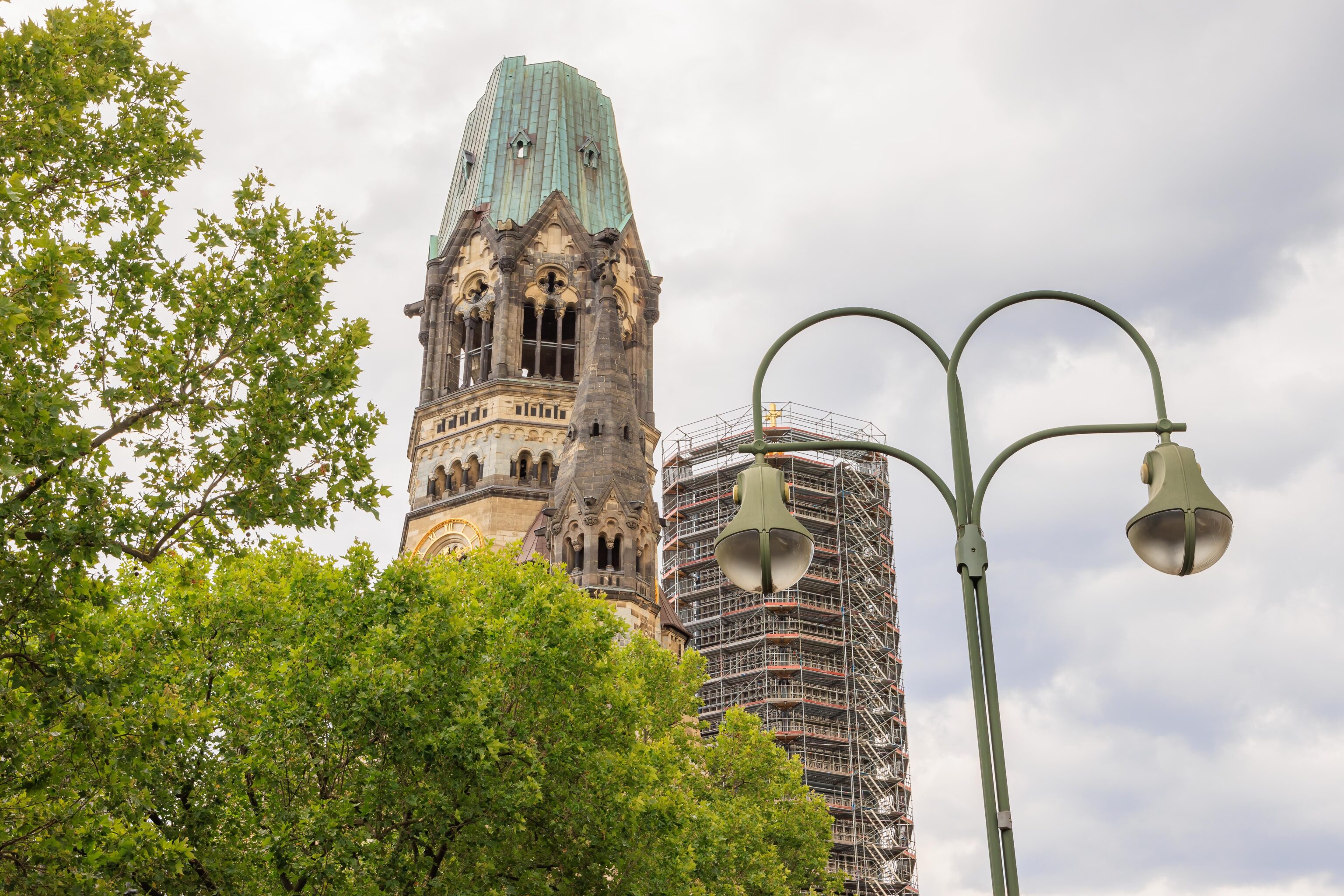
Not really any good vantage points from nearby. There’s always something in the way blocking the view! We ended up walking around to the west side to cross the street to get to the entrance.

It started raining harder as we approached. The modern looking structures are part of the new church which replaced the damaged building as a functional church. We hid under the tree on the left for a bit to wait for the rain to die down.

We noticed this building on the right. What is Bikini Berlin? Their website has a page about the history of this structure. It was apparently due to the building’s appearance in the late 50s when it was built.
The building to the left, the Zoo Palast, replaced an earlier theater that was destroyed during the war. It was the largest theater in Germany.
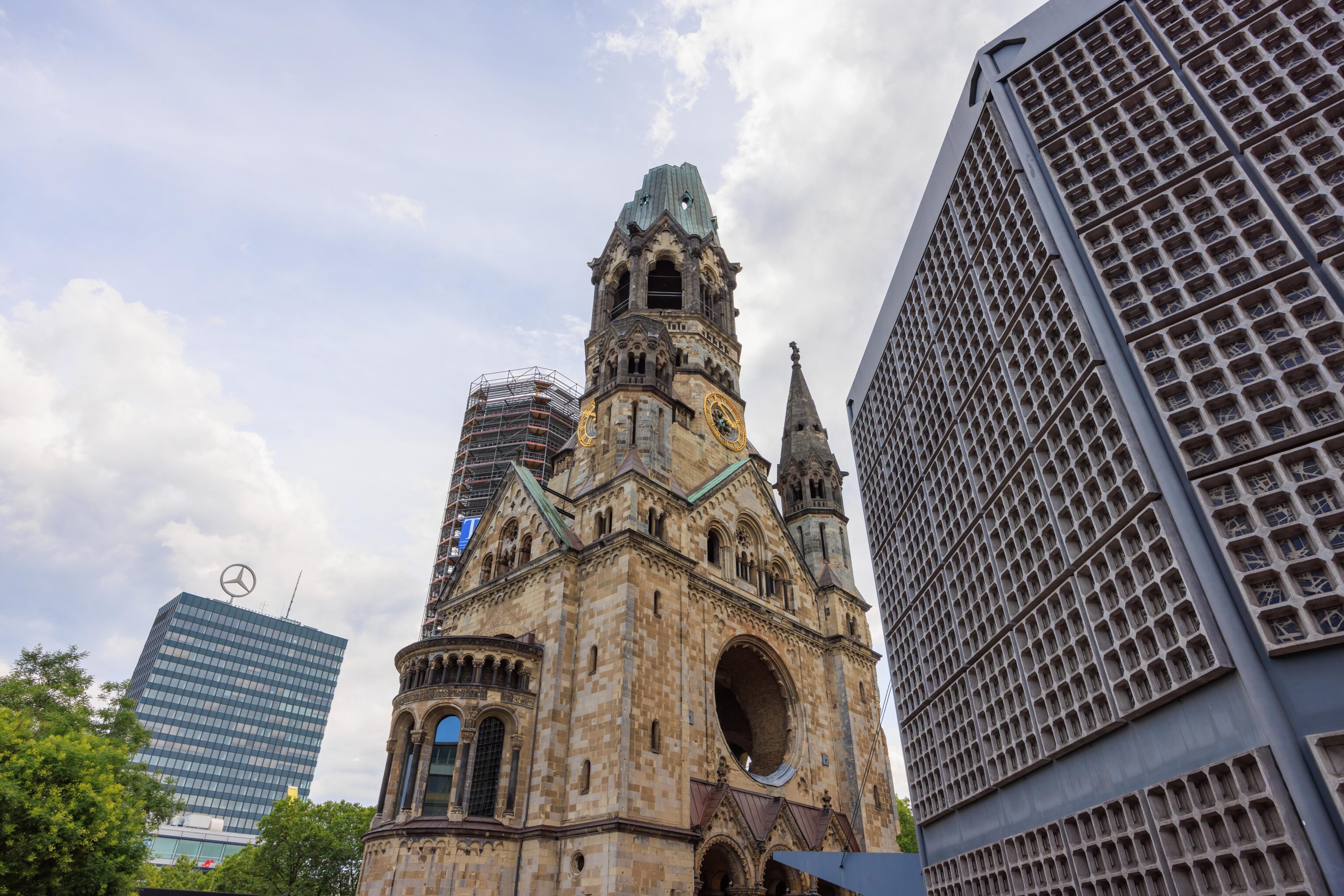
The old church building from the northwest corner. We decided to first enter the modern octagonal building on the right.

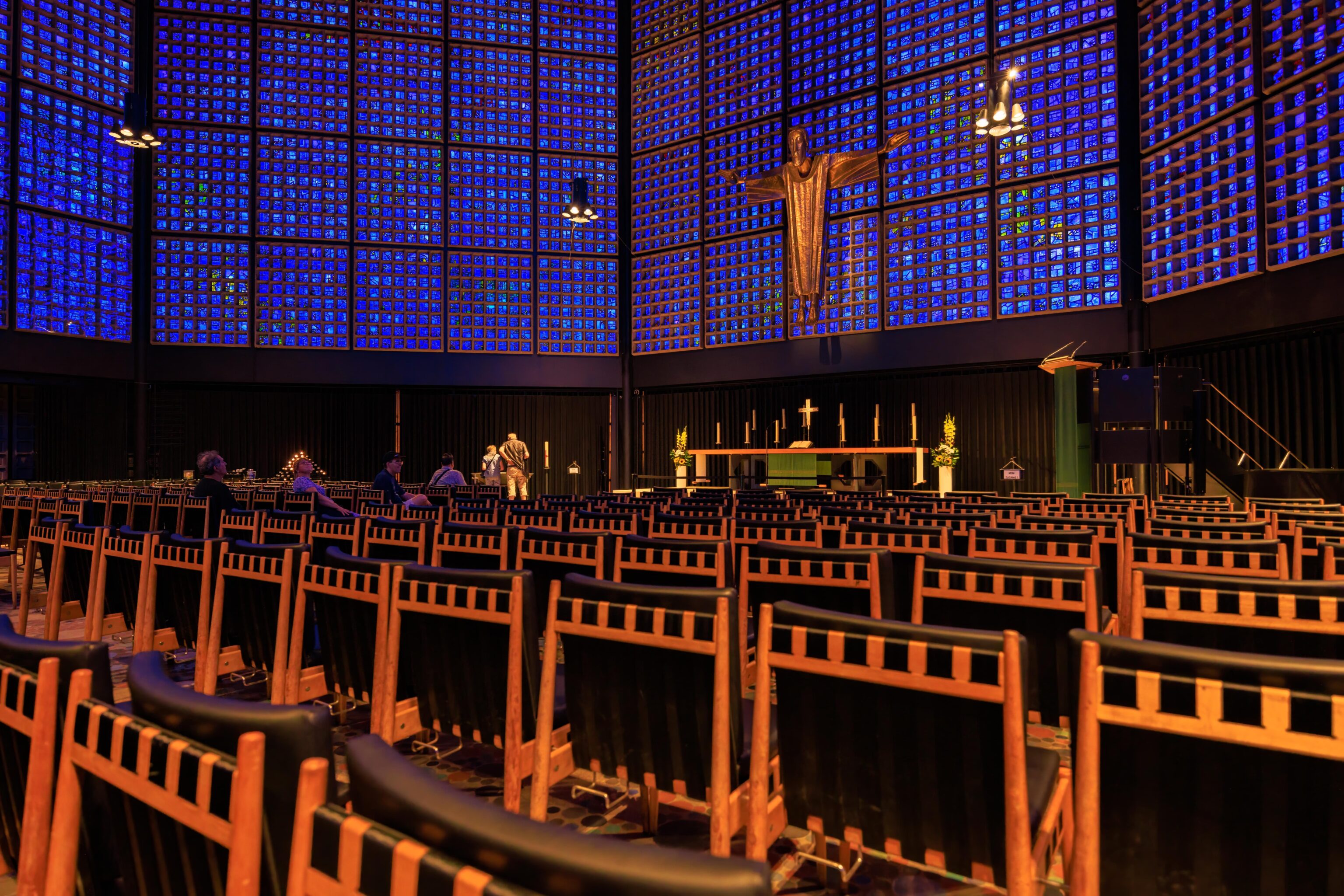
The interior of the new church is very different from most churches! All the blue was very unexpected given the building’s dull appearance from the outside.

The figure of Christ at the front is described on the church’s website:
Above the altar is suspended the figure of Christ. This sculpture, donated by Bishop Dr. Dibelius and created by the Munich artist Karl Hemmeter, is worked in tombac, a special kind of brass with a high copper content. The statue shows the resurrected Christ, in the form of a cross with His hands lifted in blessing.
It is definitely different from the usual depiction of Christ.

There is, of course, an organ.
Afterwards, we went to the remains of the old church. The building was rather crowded as the renaming space is small and there were many people visiting.

The tiled mosaic ceiling is quite elaborate and impressive. It shows sign of damage but is otherwise surprisingly intact.

There was also a tiled mosaic on the floor. Also very beautiful and impressive. It was always very busy so I was never able to get a good wide angle photo of it.
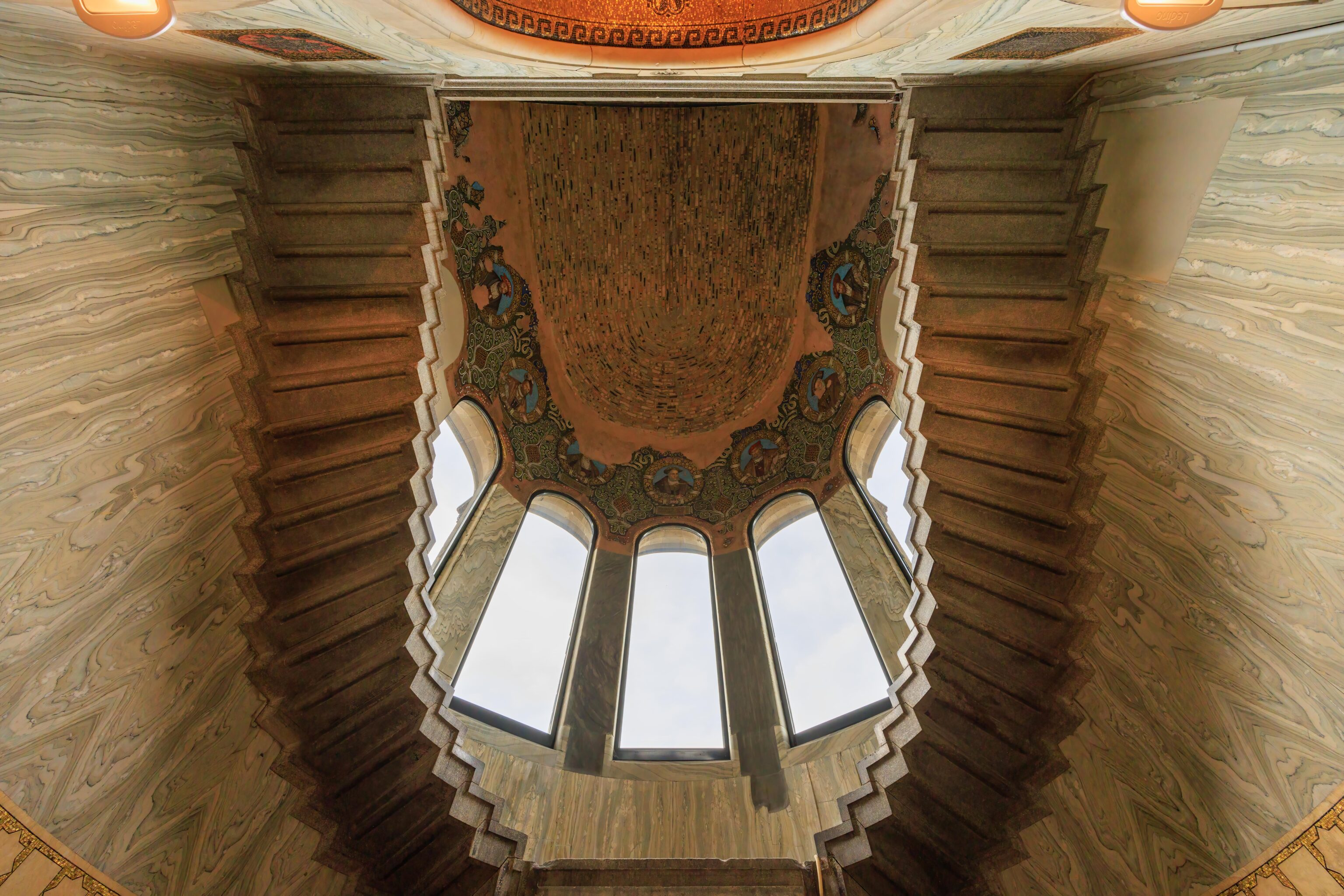

This is the north end of the church. This section is a bit odd with stairs that seem to lead to nowhere. Not sure how this was in the original design.

This says “es ist vollbracht” – all is done.
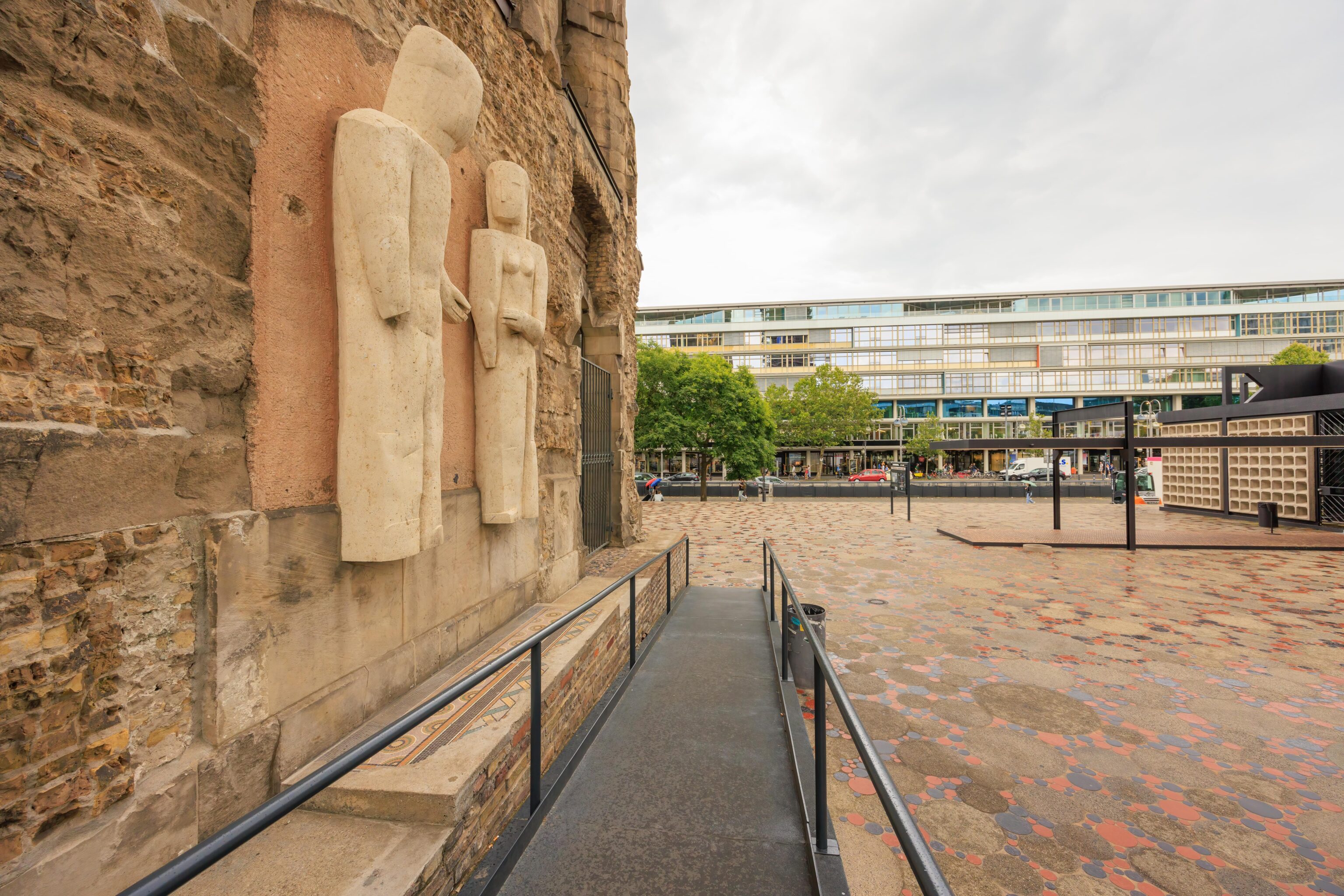
Afterwards, we headed outside via an exit on the east side of the church, opposite where we entered.

One final look at the building from up close before moving on.

We headed southeast to the Wittenbergplatz U-Bahn station. There wasn’t much of note on the way, mostly just shops and offices. We did notice this large sculpture though. The Berlin state website has a page in German, in English, it reads (translated via Google Translate):
The sculpture on the median of Tauentzienstraße, between Nürnberger and Marburger Straße, was created in 1987 by Brigitte and Martin Matschinsky-Denninghoff as a contribution to the sculpture boulevard and was initially only temporary, later purchased by the Senate and installed permanently. The monumental, gate-like sculpture made of chrome-nickel steel tubes symbolized the situation of divided Berlin with its two intertwined parts that were set up separately. The gate formed by the sculpture can be walked through in an east-west direction. With the Kaiser Wilhelm Memorial Church in the background, “Berlin” quickly became one of the most popular photo motifs in Berlin.

We sat for a bit by these flowers and department store, Kaufhaus des Westens, for a quick break. It is apparently the second largest department store in all of Europe.
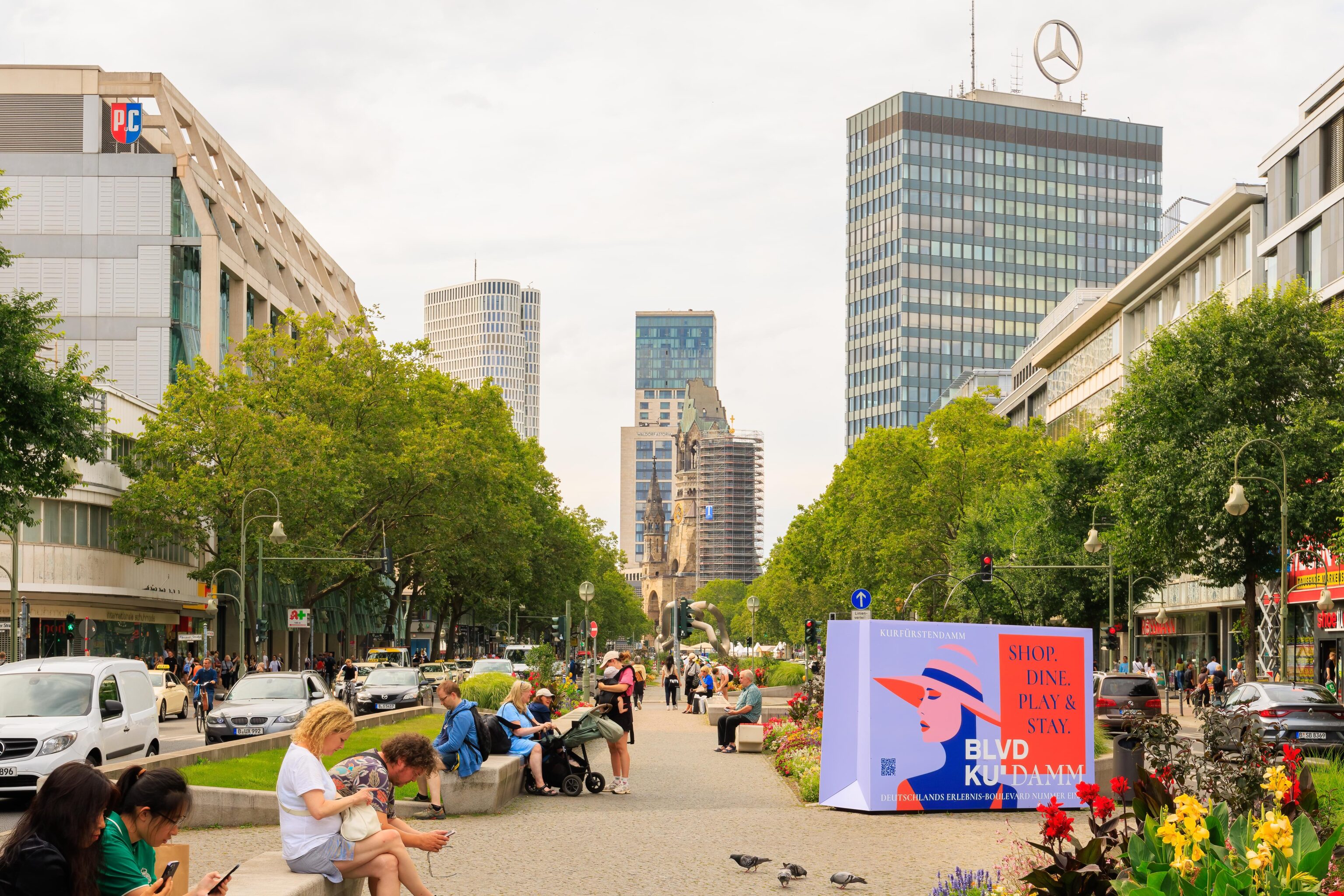
The view to the northwest where we came from. The Kaiser-Wilhelm-Gedächtniskirche can be seen in the distance.

The Wittenbergplatz U-Bahn station actually has a building! Most of the stations we saw just have stairs that lead underground. The U-Bahn actually comes out from underground for awhile to the east of this station. There is even an elevated portion! We took the U2 line to Stadtmitte, a few blocks from our hotel.
Stadtmitte
We walked over to Ritter Sport Bunte Schokowelt Berlin (Ritter Sport Colorful Chocolate World Berlin). We’ve had chocolates from this German chocolatier before in Japan. We just briefly popped in to get an eiskaffee.
Our next stop was Julian & Elisa, an ice cream shop. It started to pour right after we ordered. But, we were able to grab an outdoor table and drag it under an overhang so we wouldn’t get wet.

We had one of their strawberry items as well as three ice cream scoops – raspberry, orange, espresso. Pretty good!

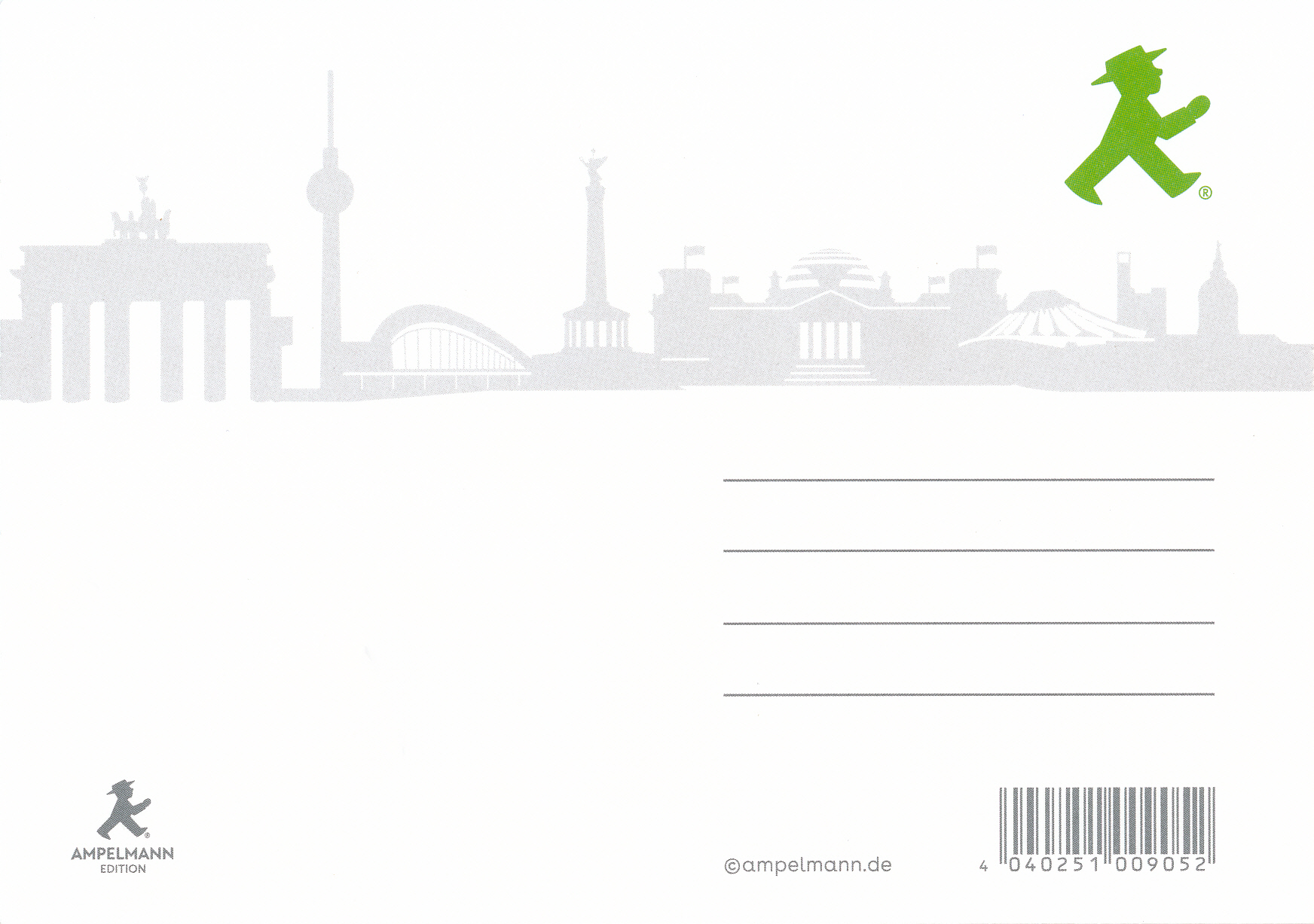
It stopped raining after we finished so we headed back towards the The Westin Grand Berlin. But, we dropped by the Ampelmann store first. It was the only gift shop type establishment that we visited this trip, other than the ones attached to some tourist site.
We were thinking about heading out again in the evening to get a light dinner. But then the sky opened up and it started pouring. It rained extremely hard with high wind and thunder and lightning. Luckily, this was the only real bad weather that we saw on this trip.
After the rain down, we took the U-Bahn to the Mohrenstraße station. Teras, a döner kebab restaurant, was right there by the exit that we took. While waiting to order, we noticed some pictures on the wall. Former German Chancellor Angela Merkel is a customer! There were a few photos with her of varying age. There were also other photos of presumably well known people but we didn’t know who they were.

We decided to get their big döner as it comes with extra meat. Very good! We also got fries and a currywurst. They were pretty mediocre. Stick to döner when going to a döner place!


